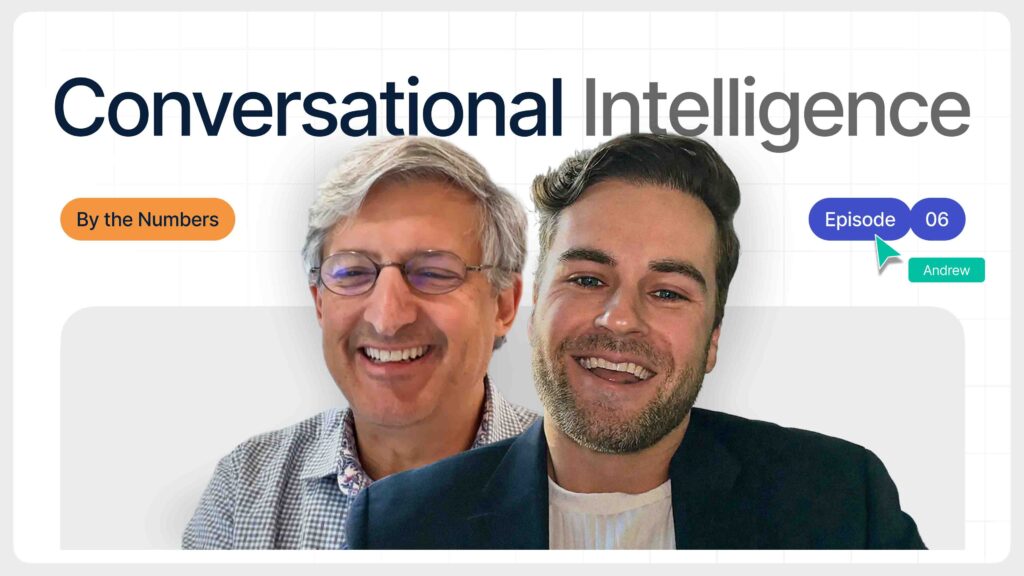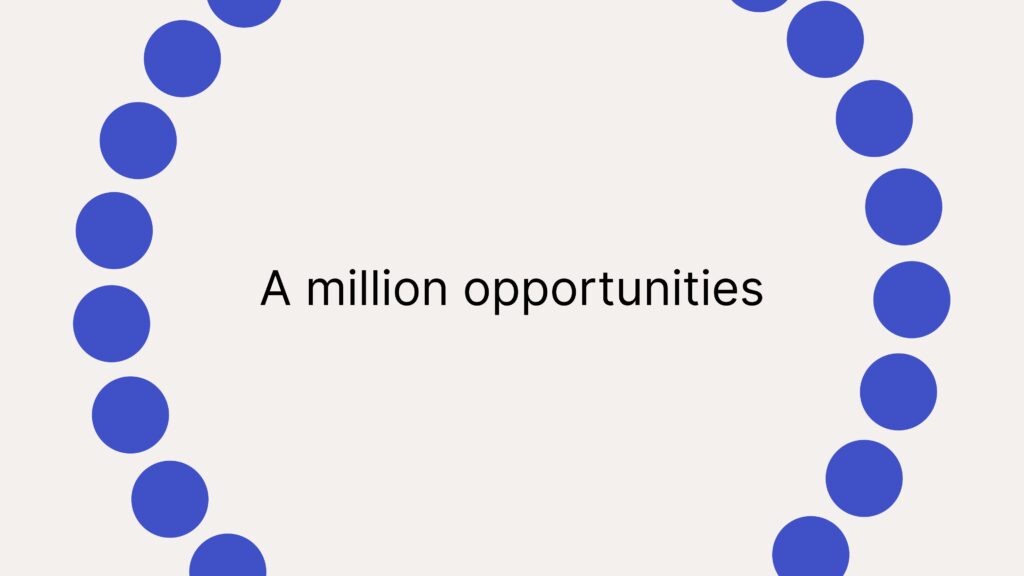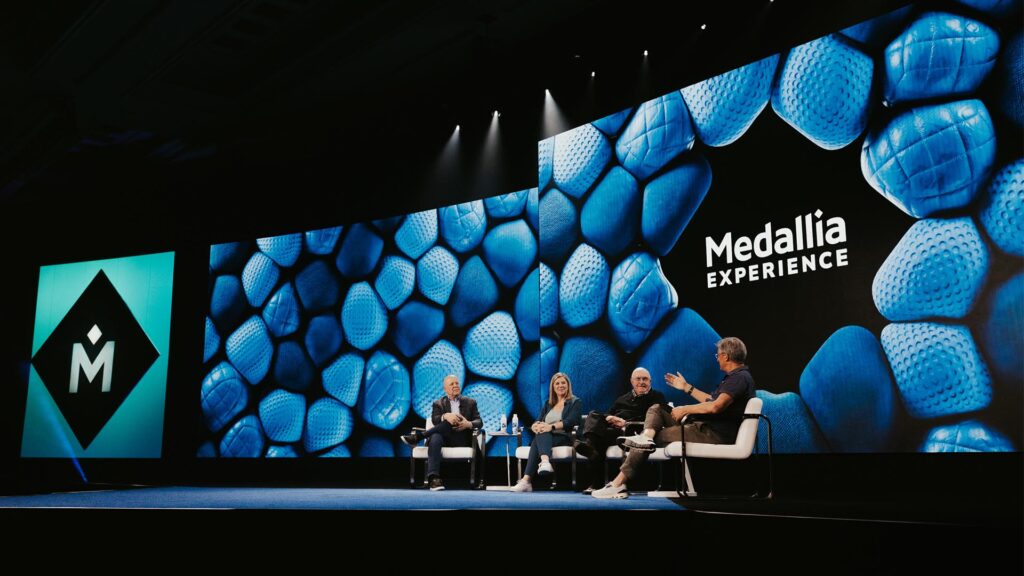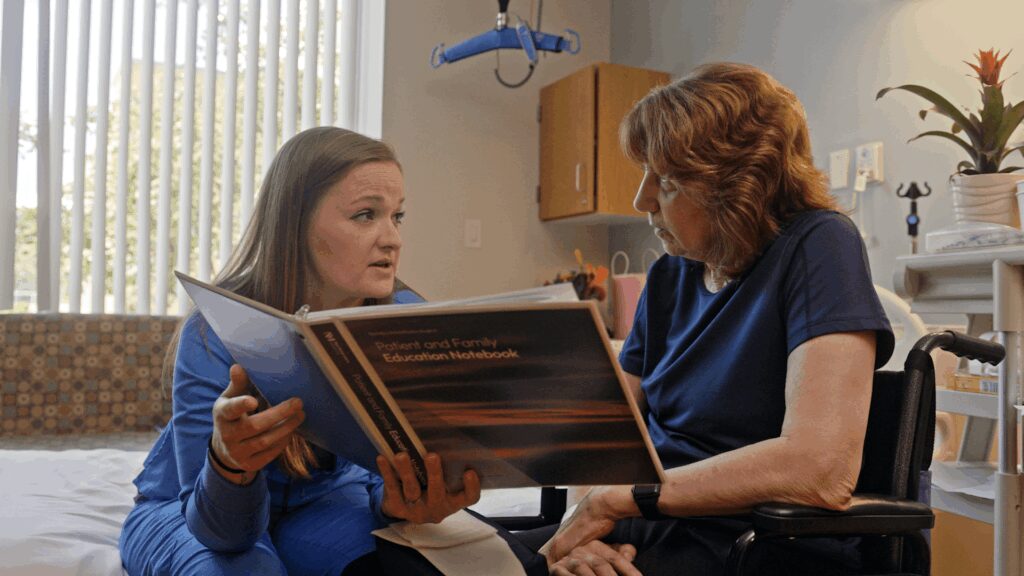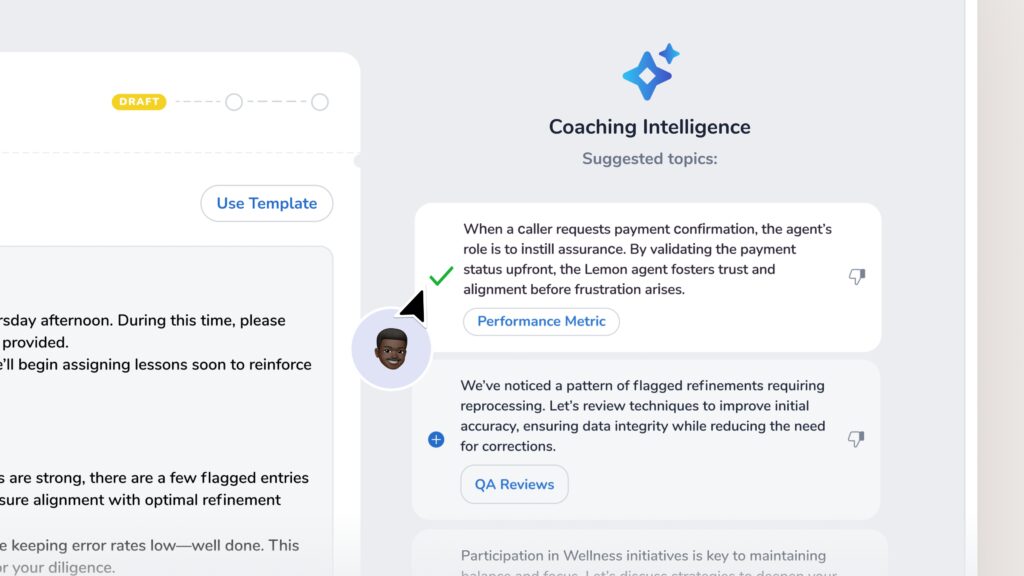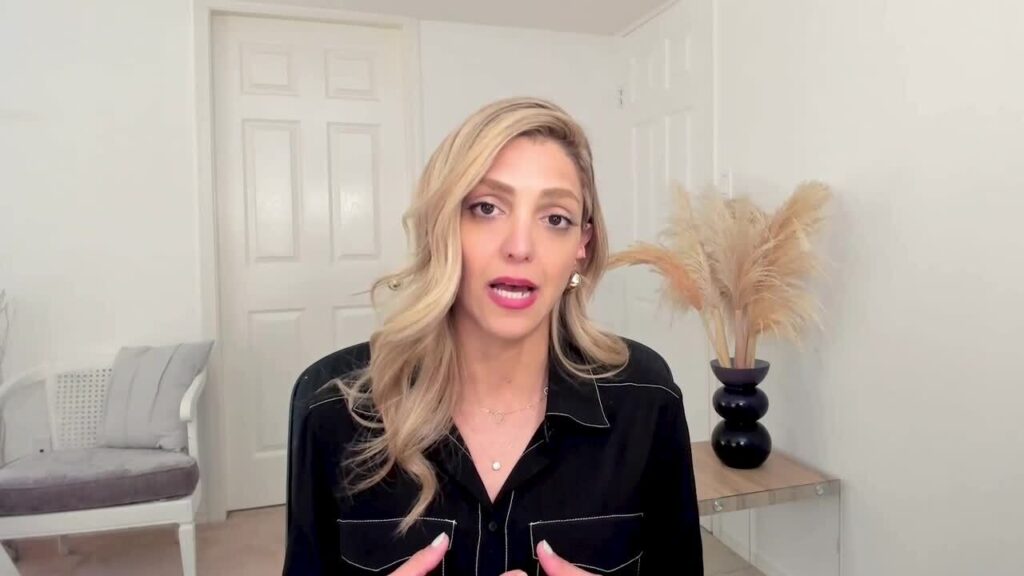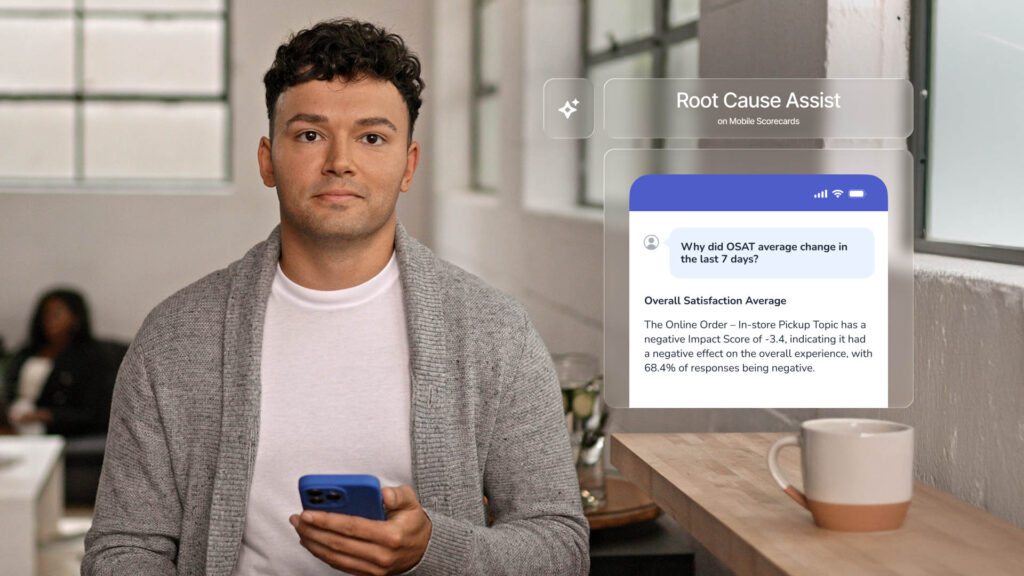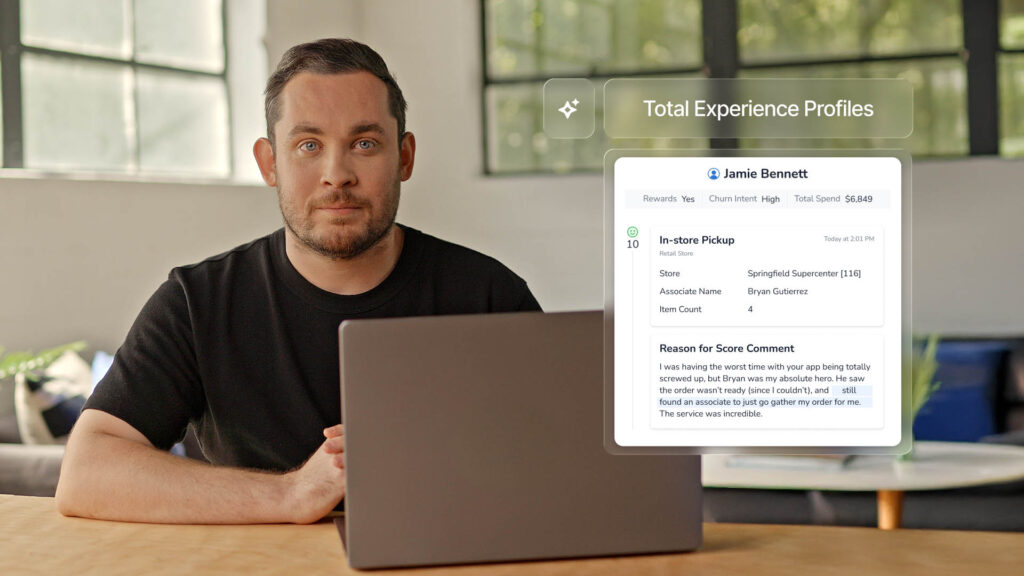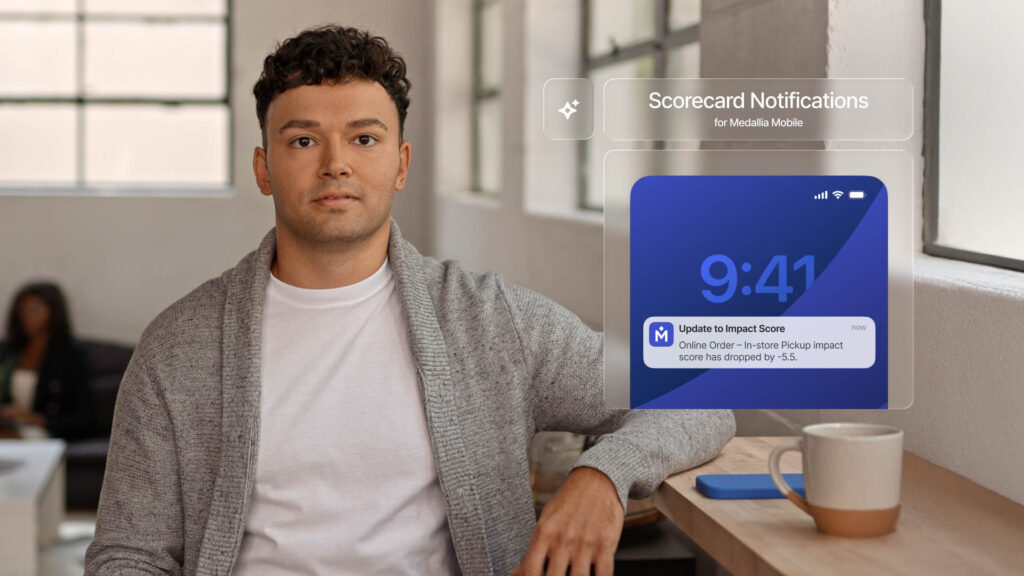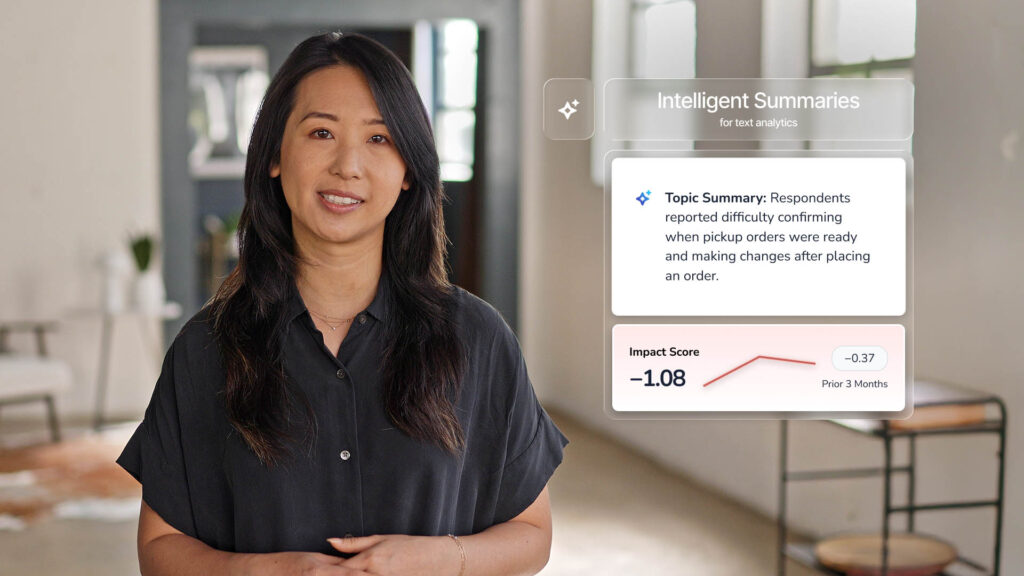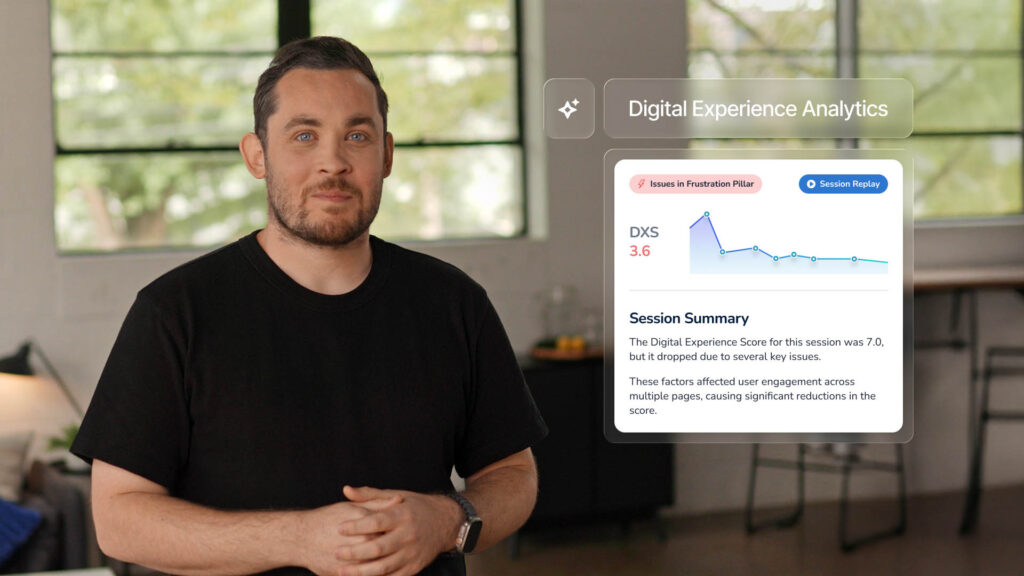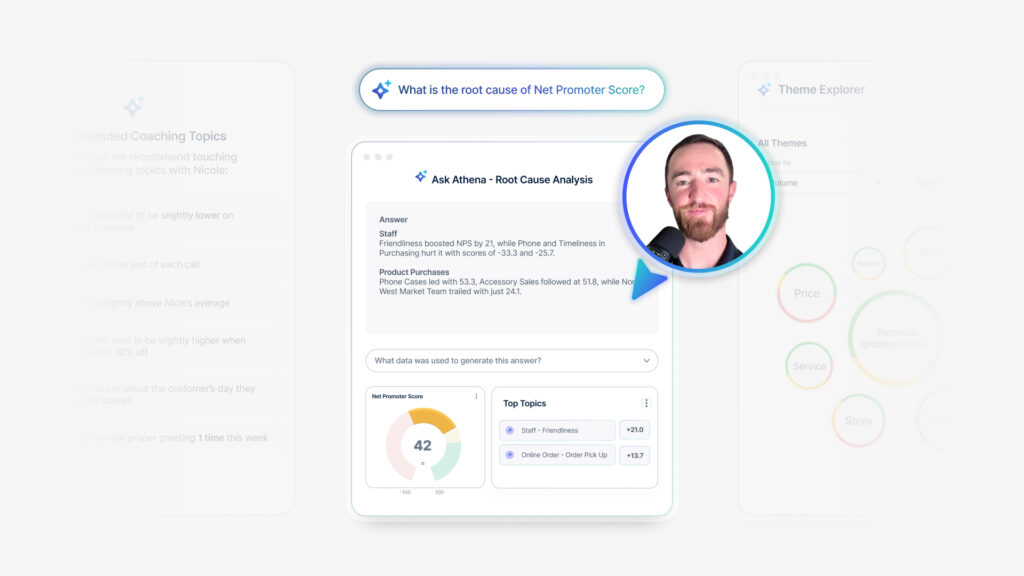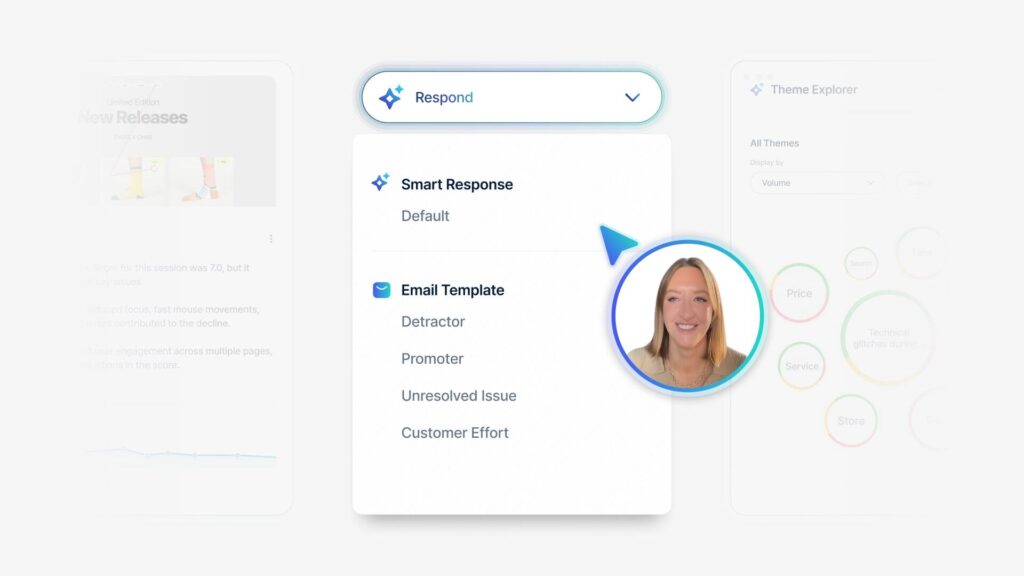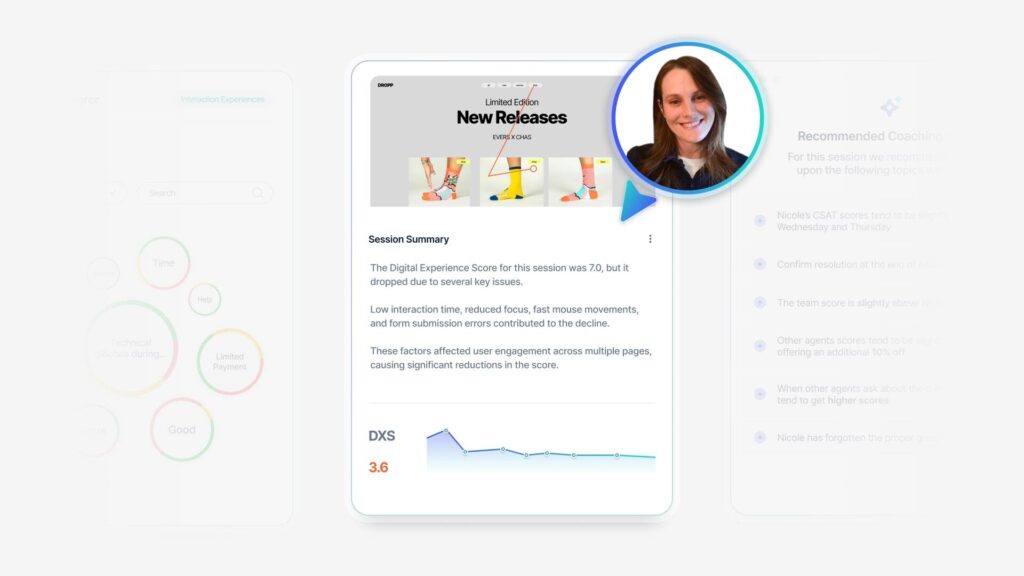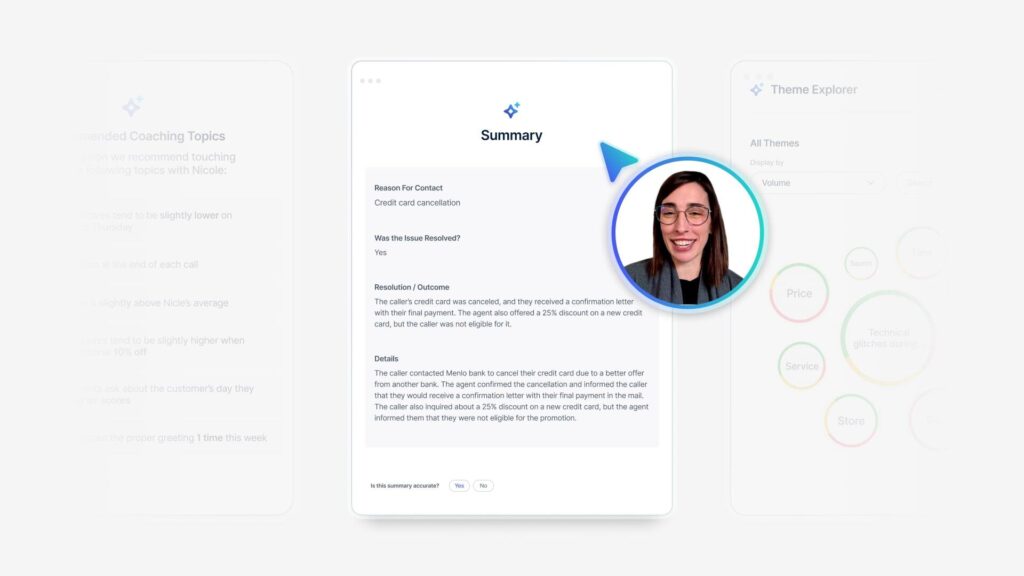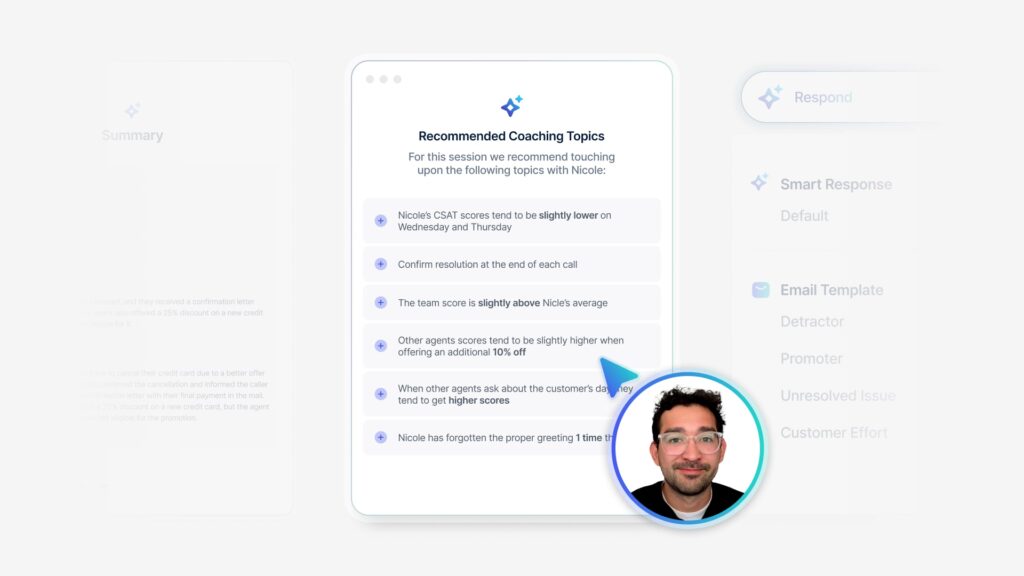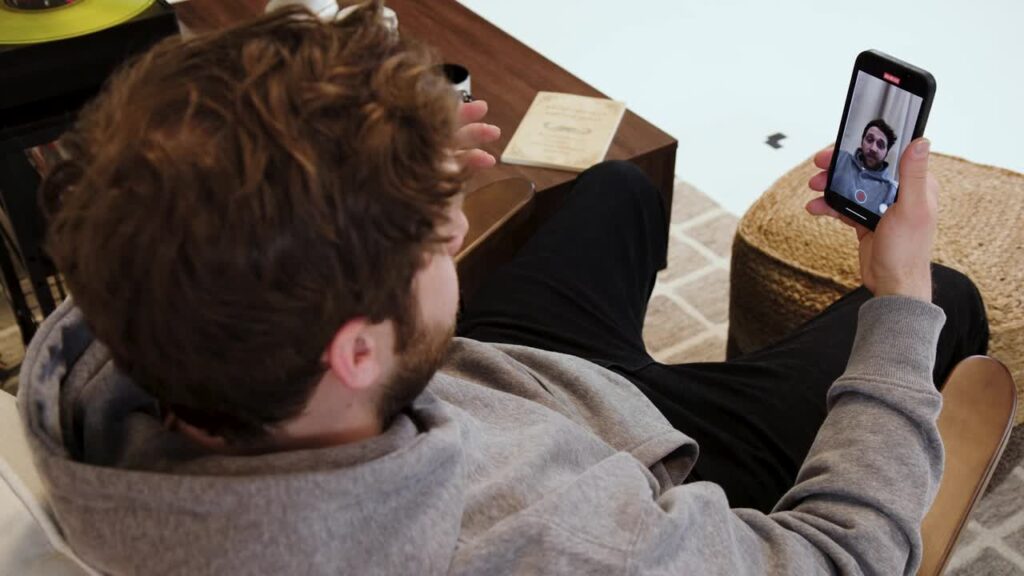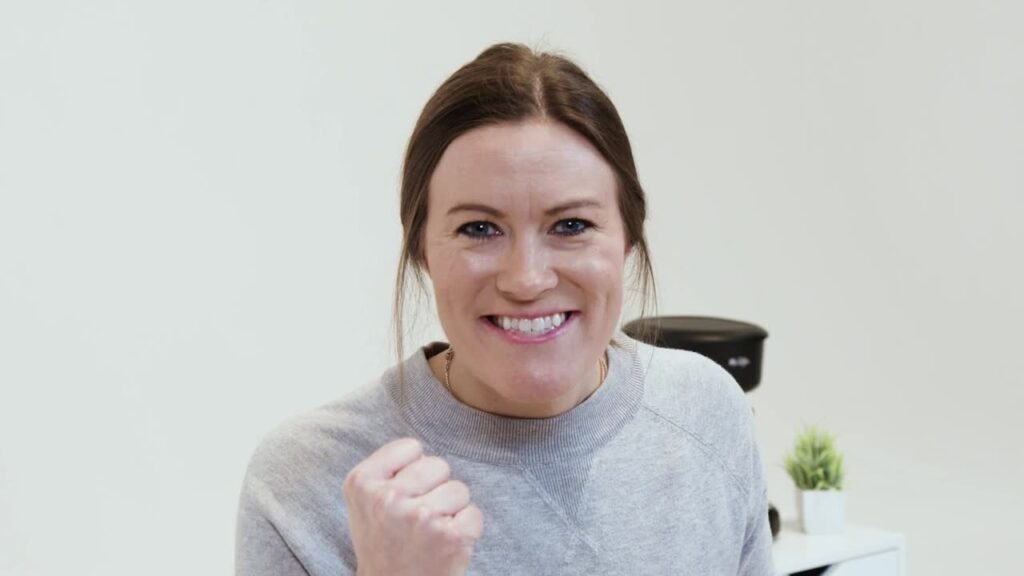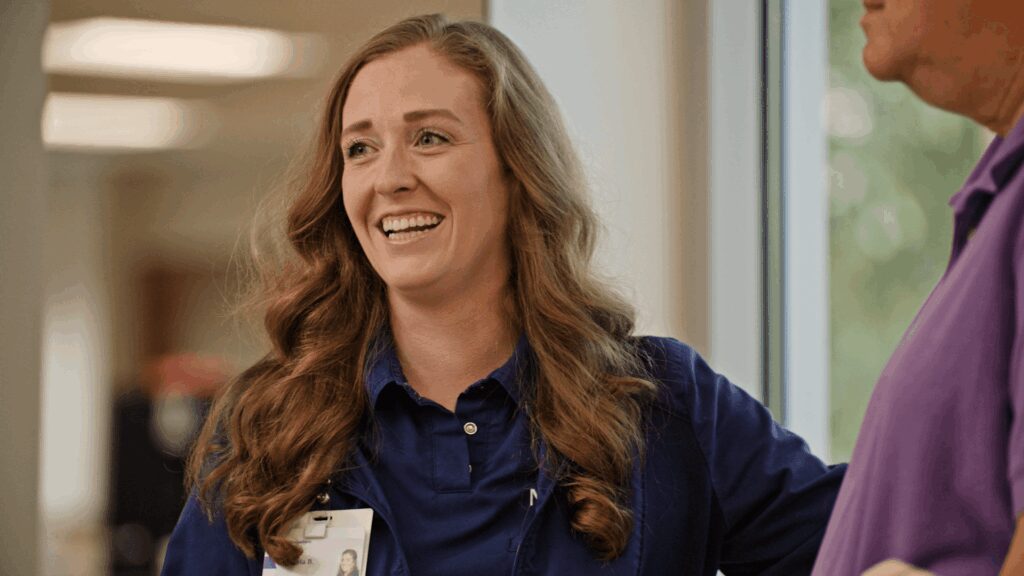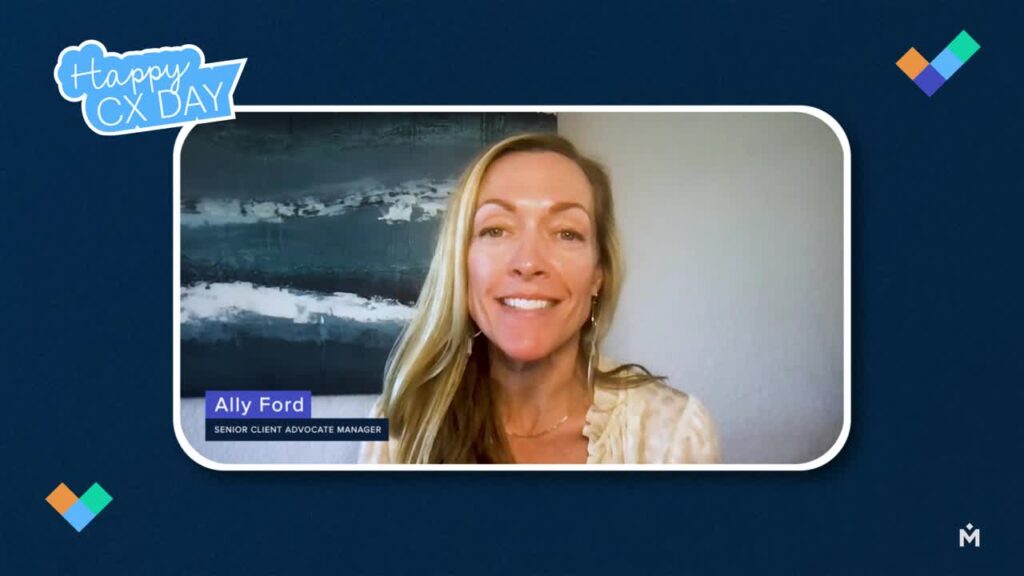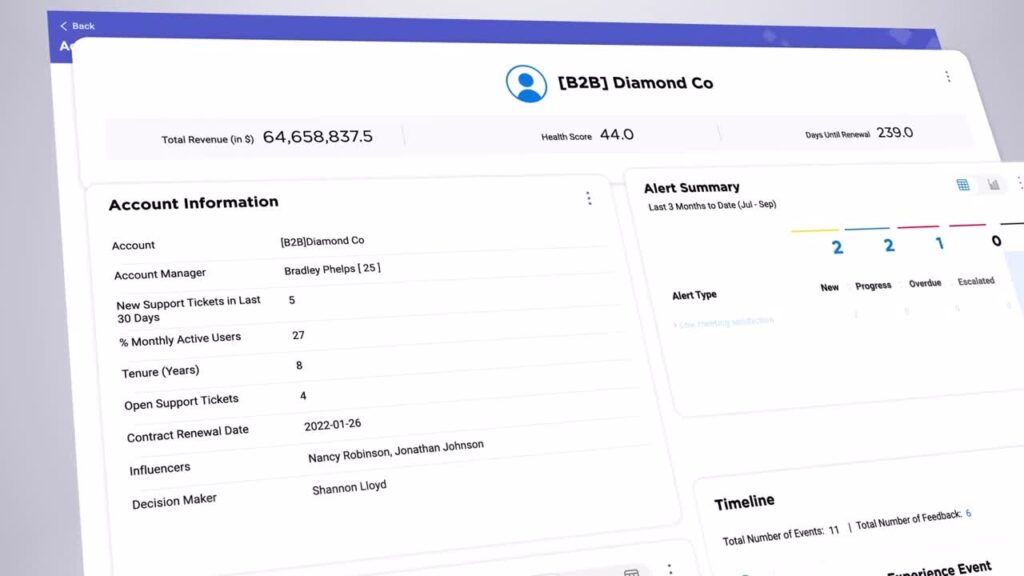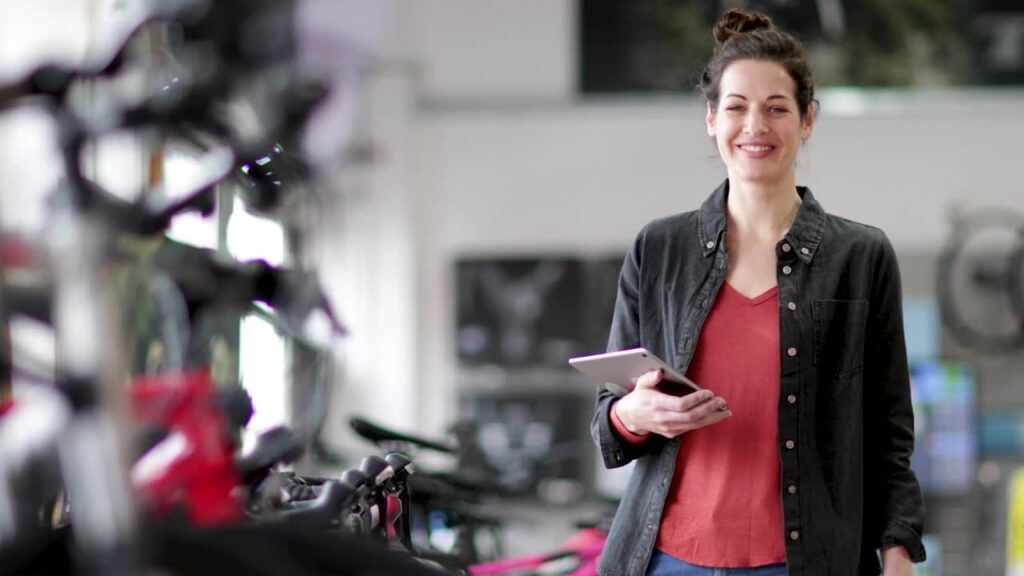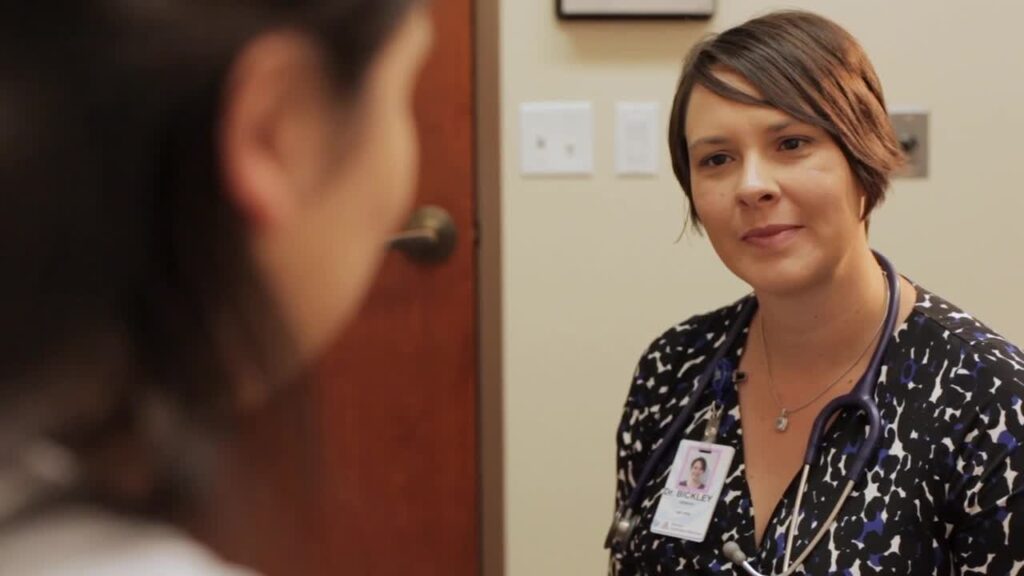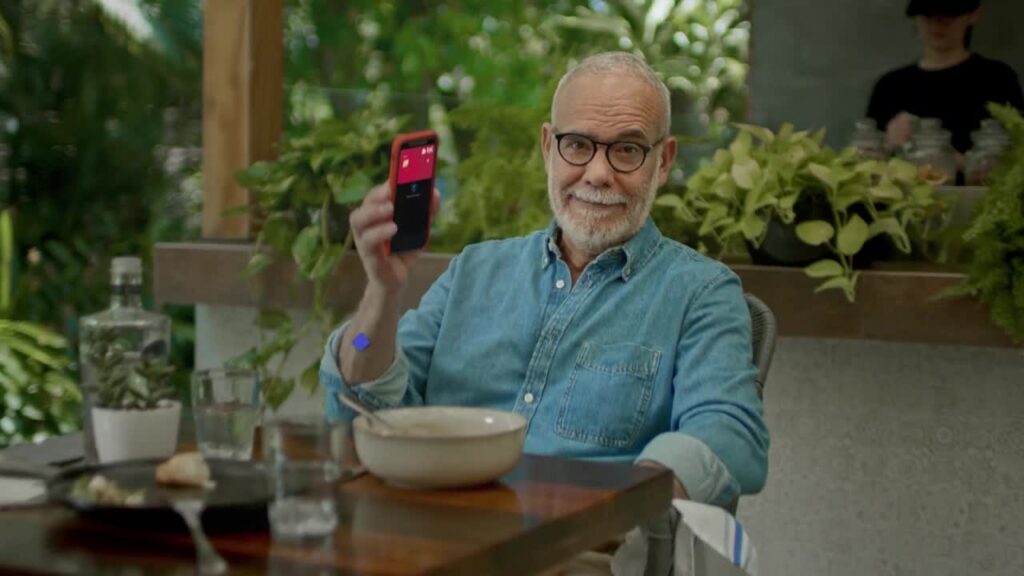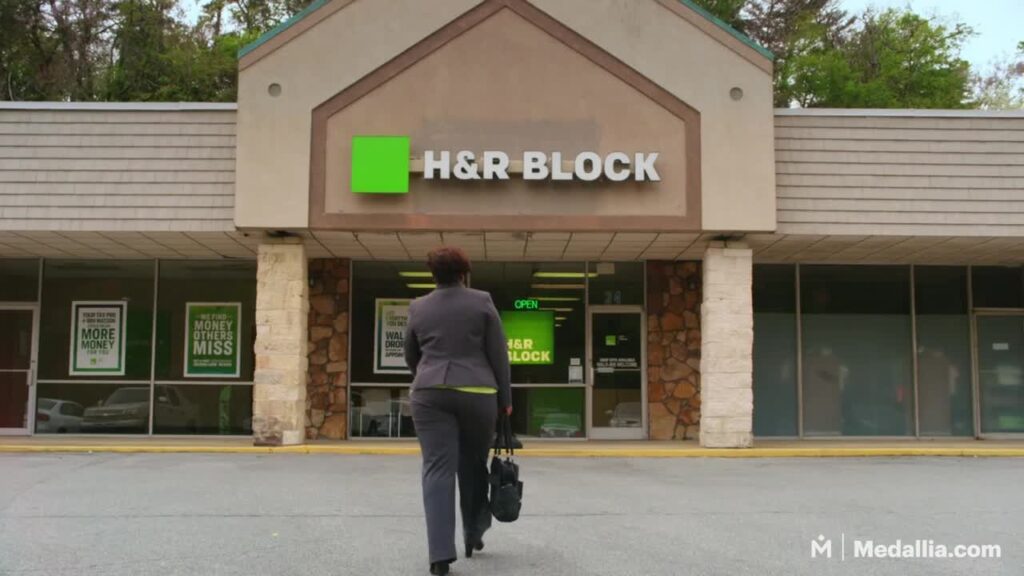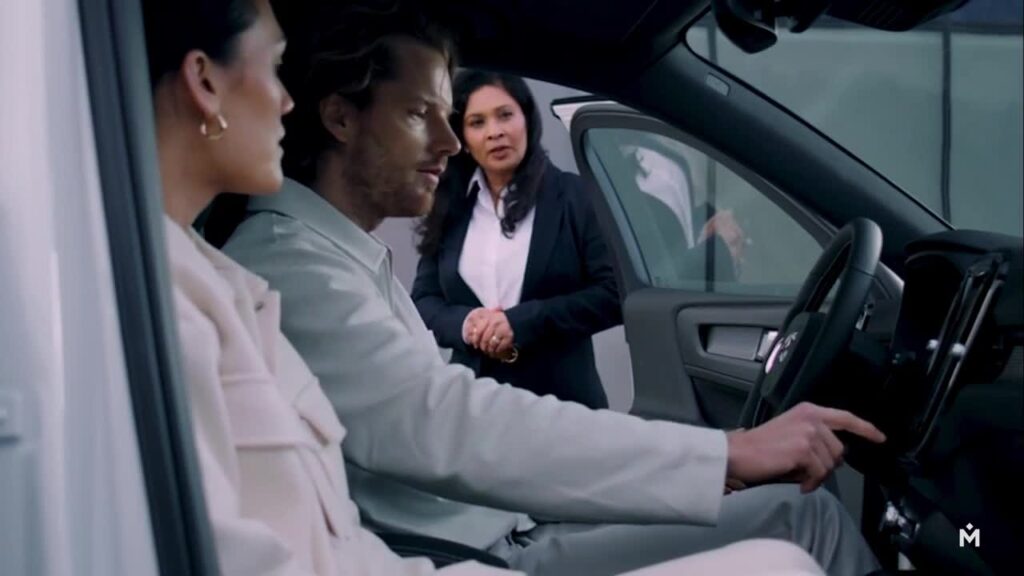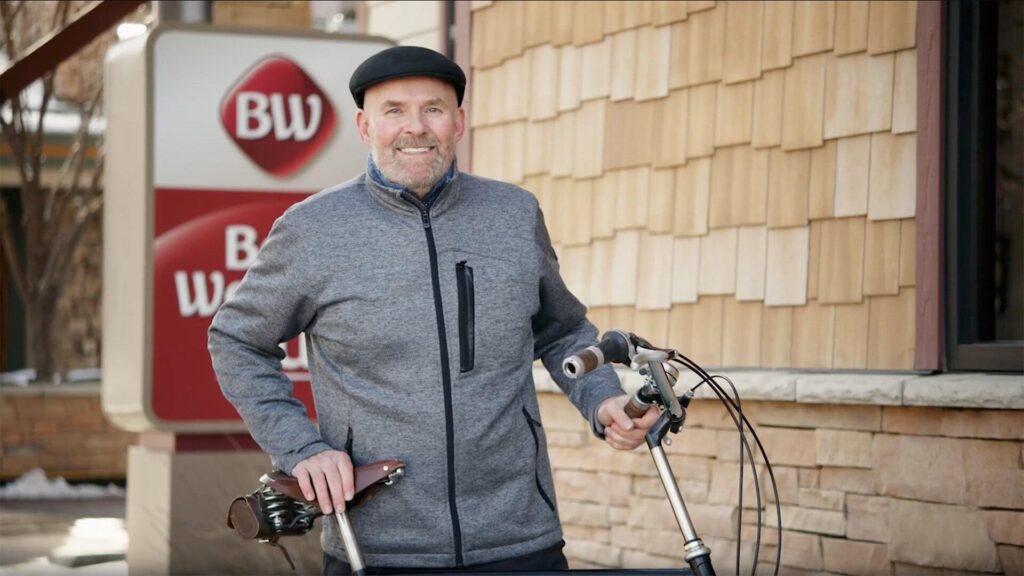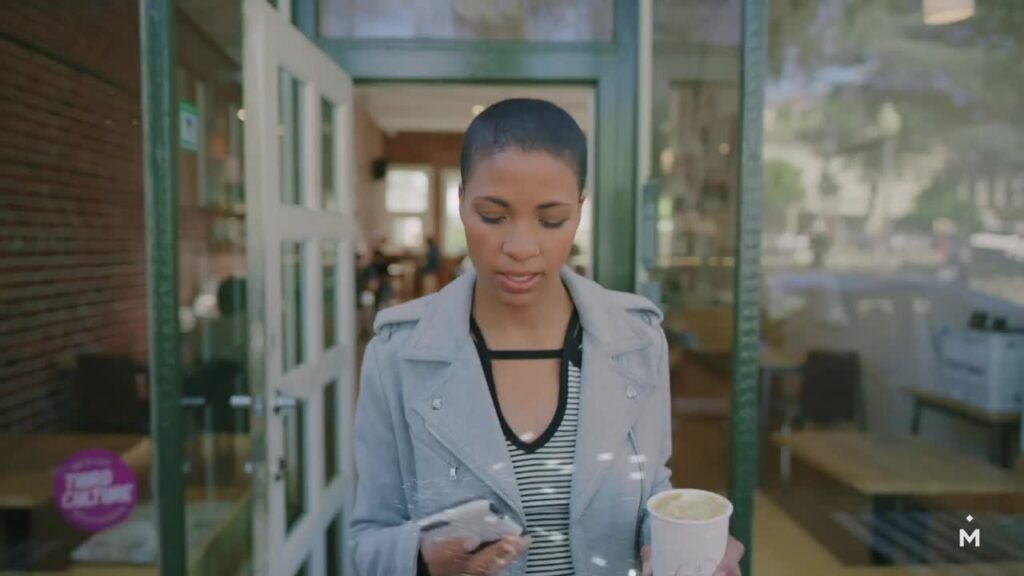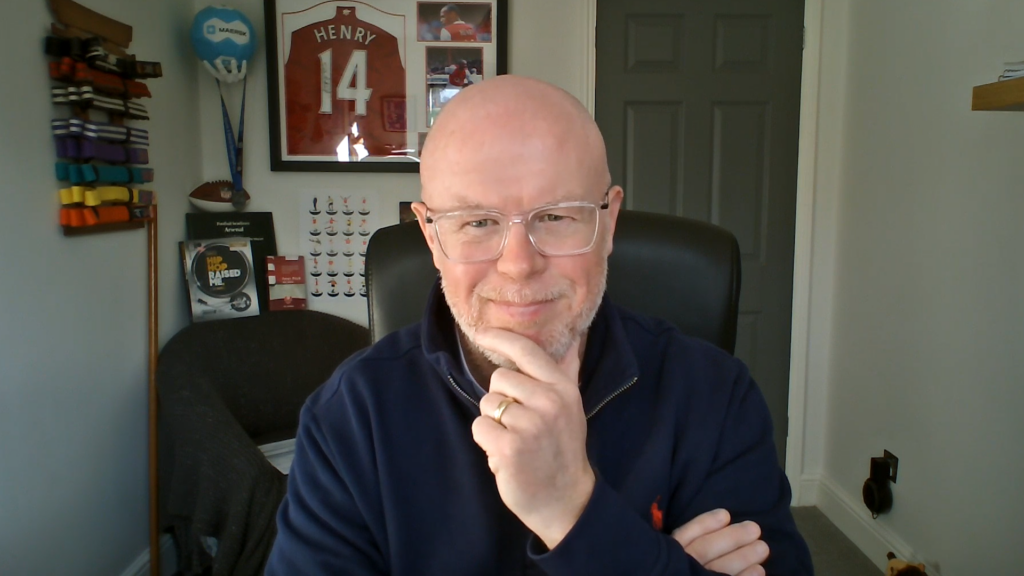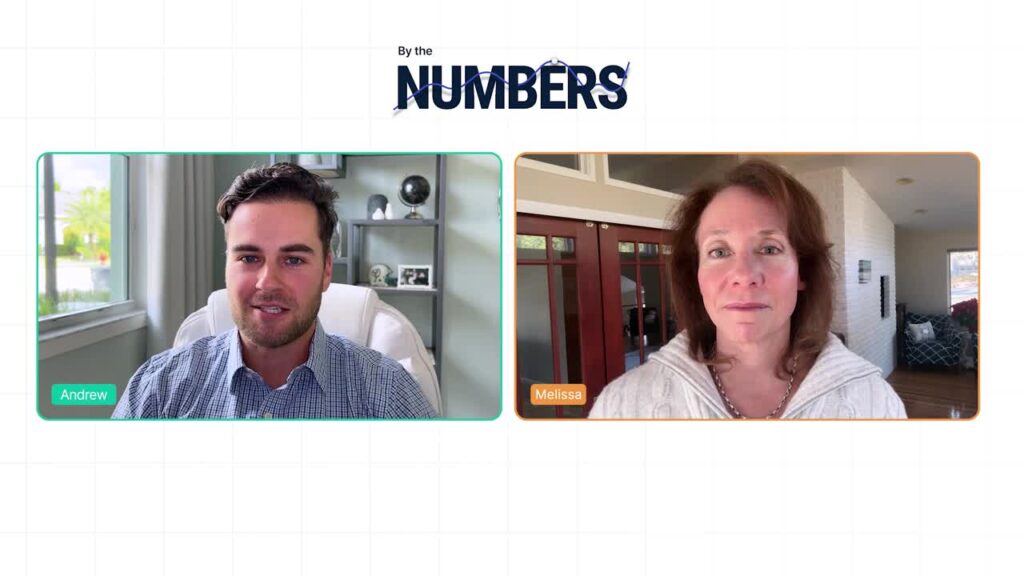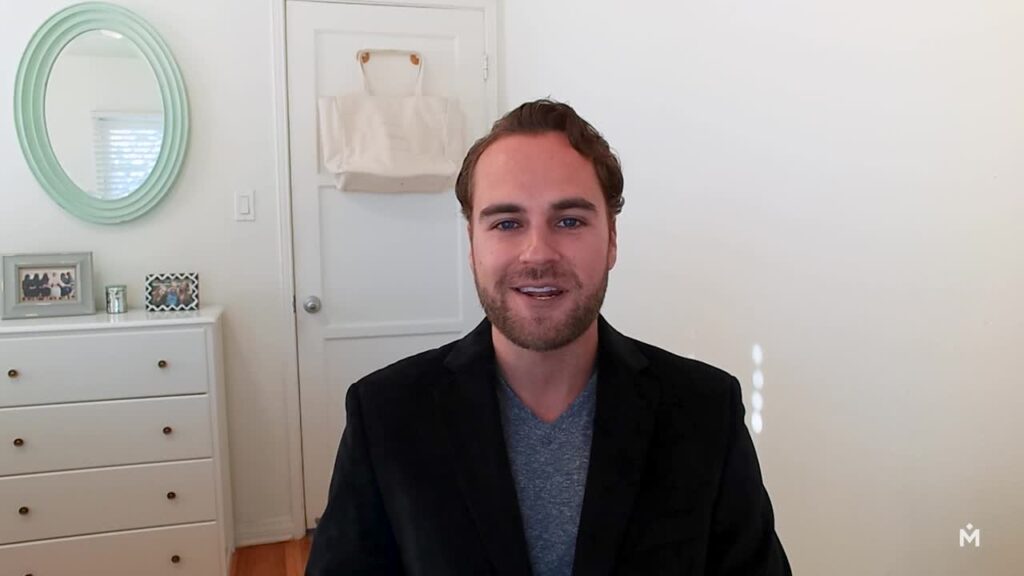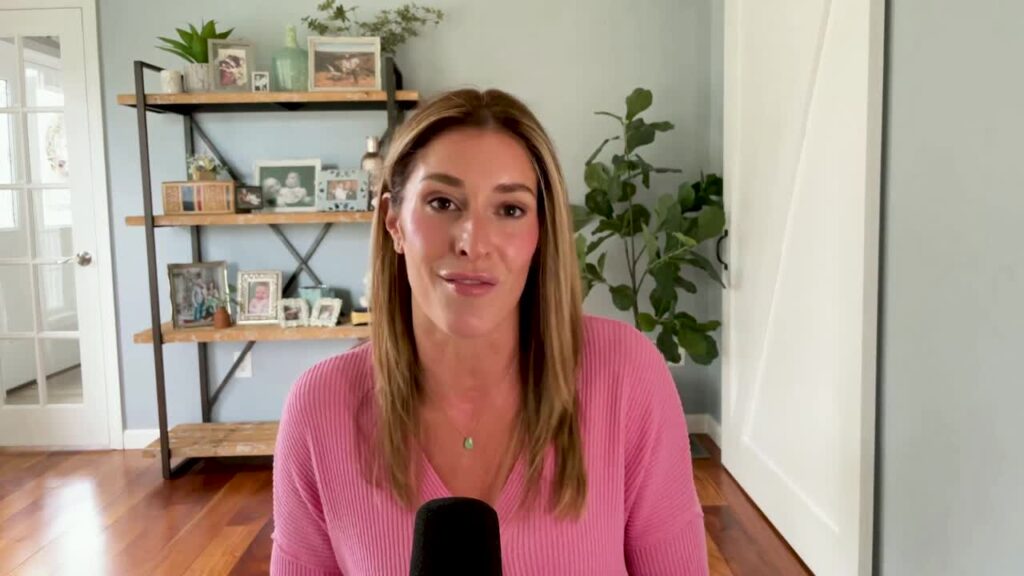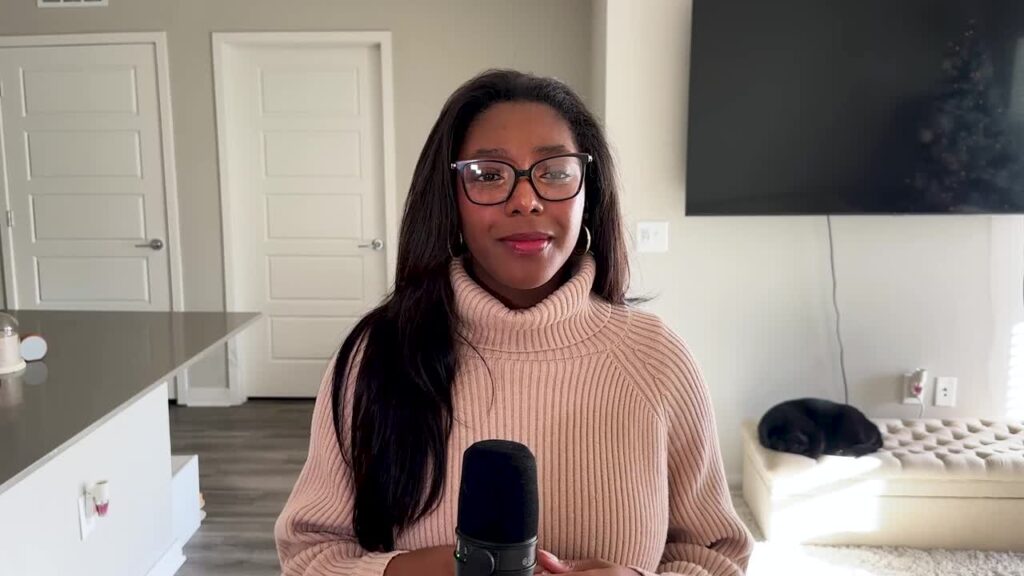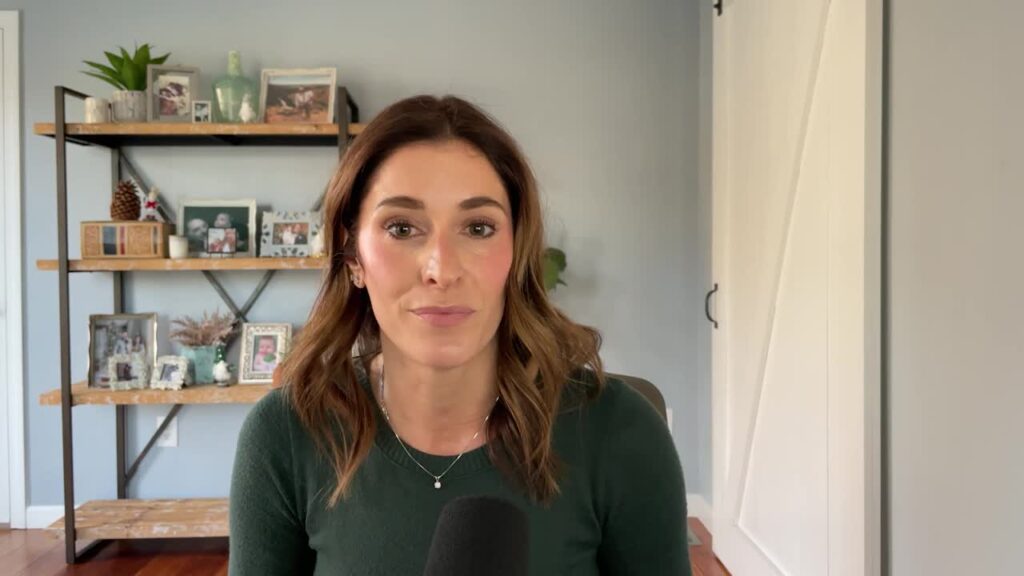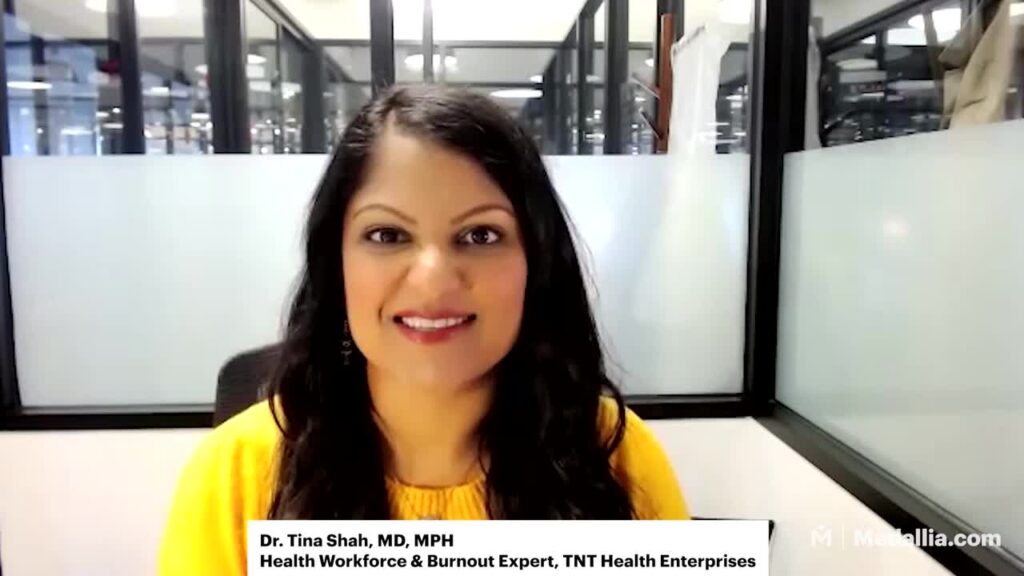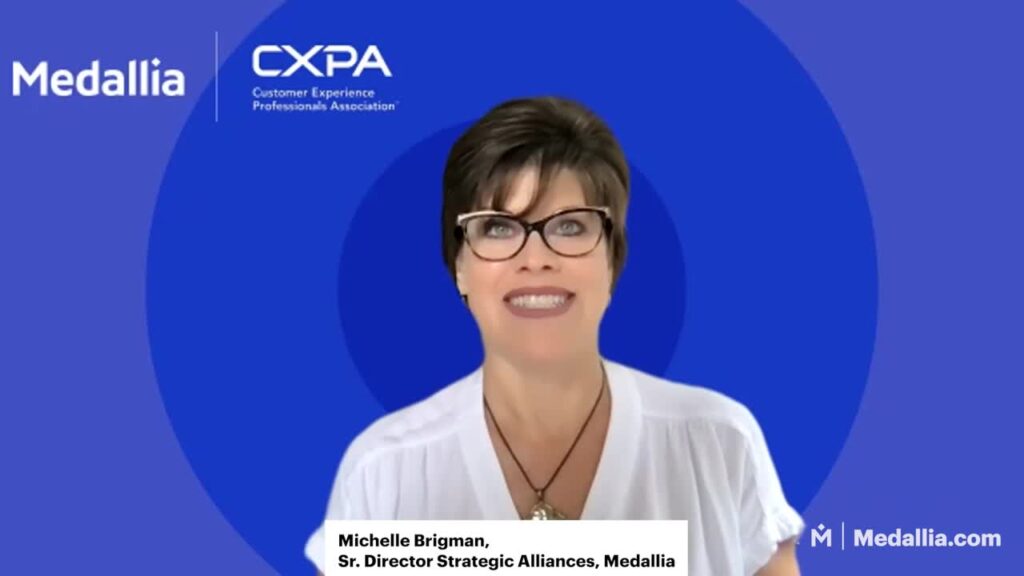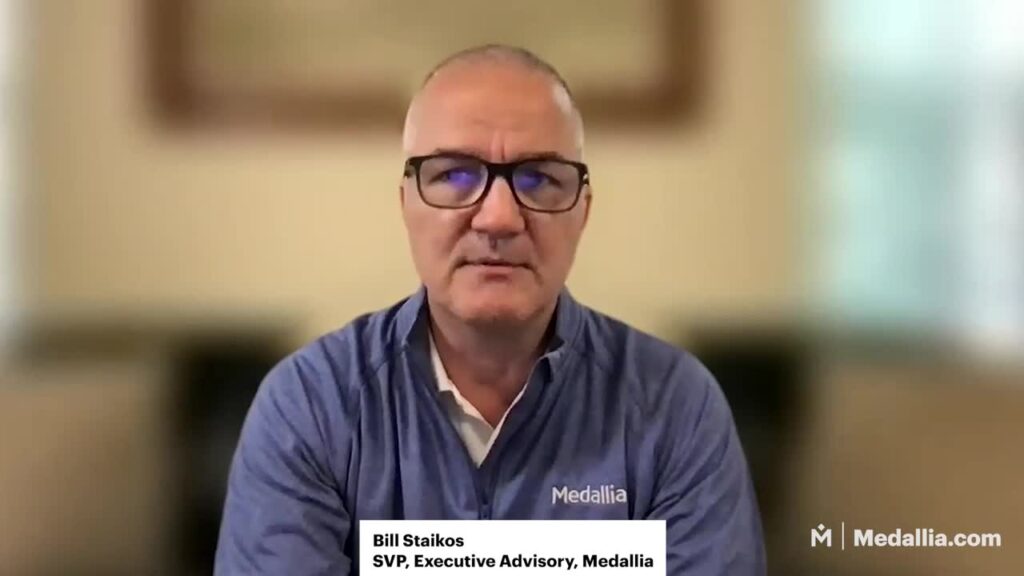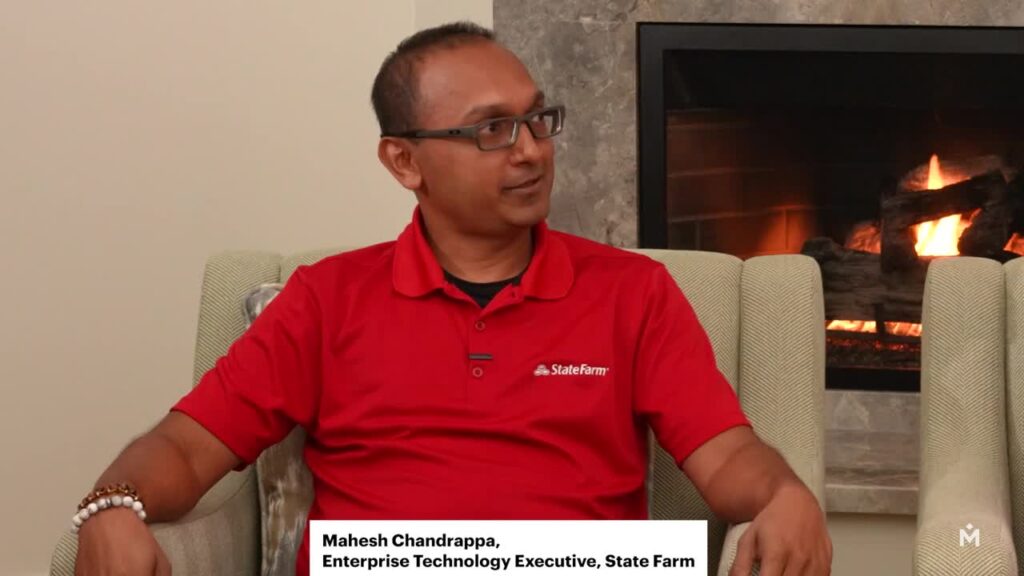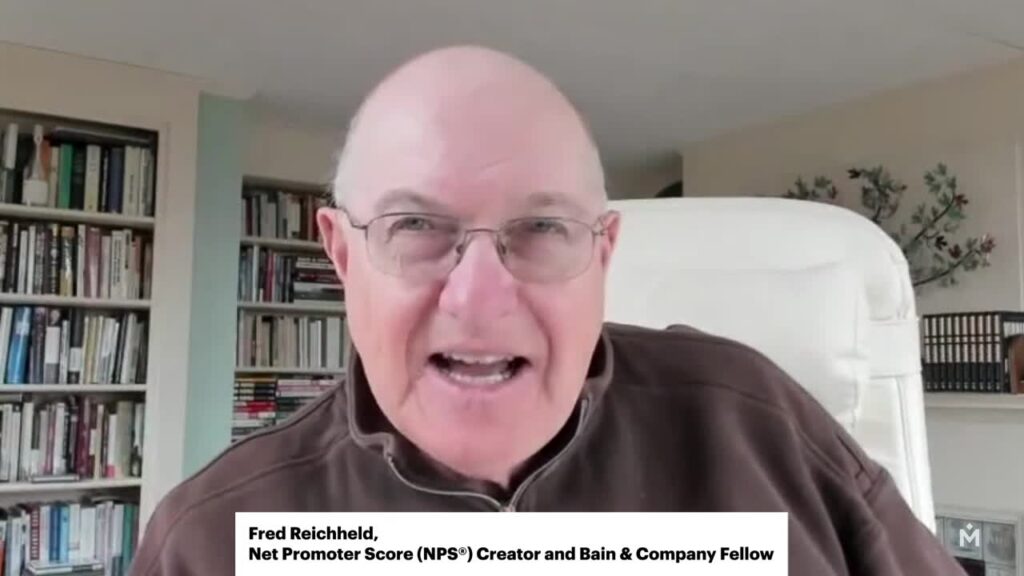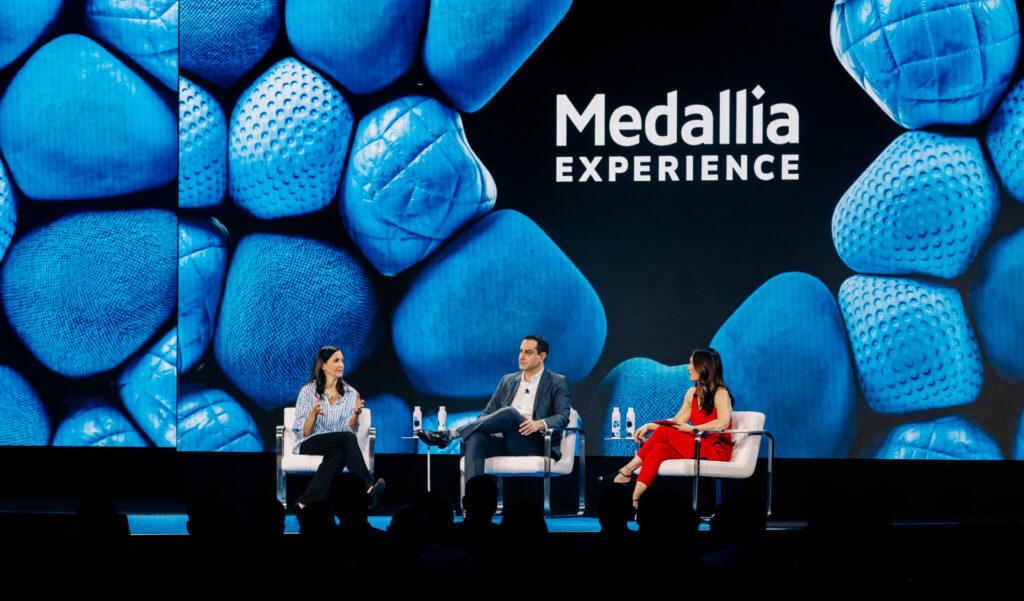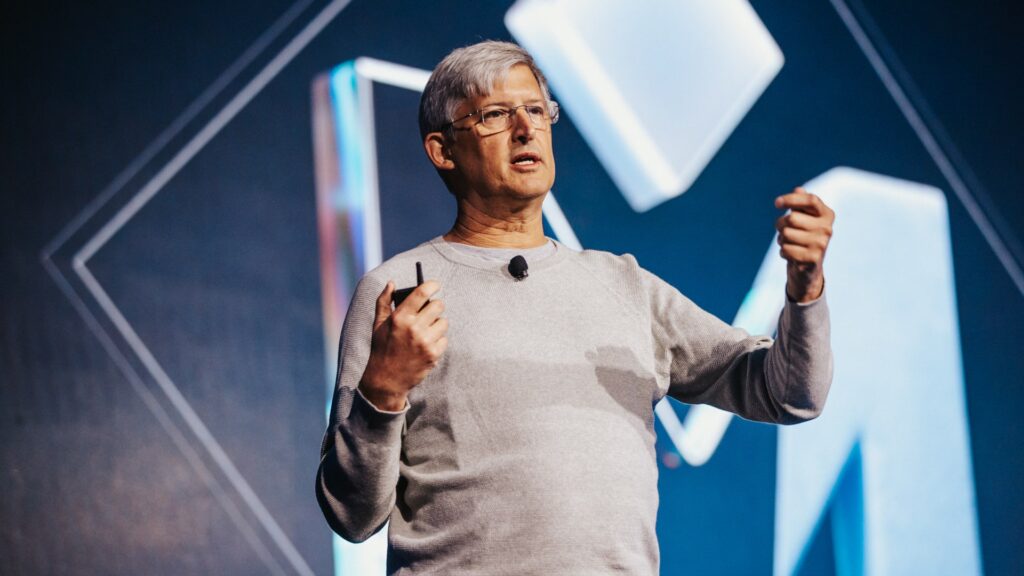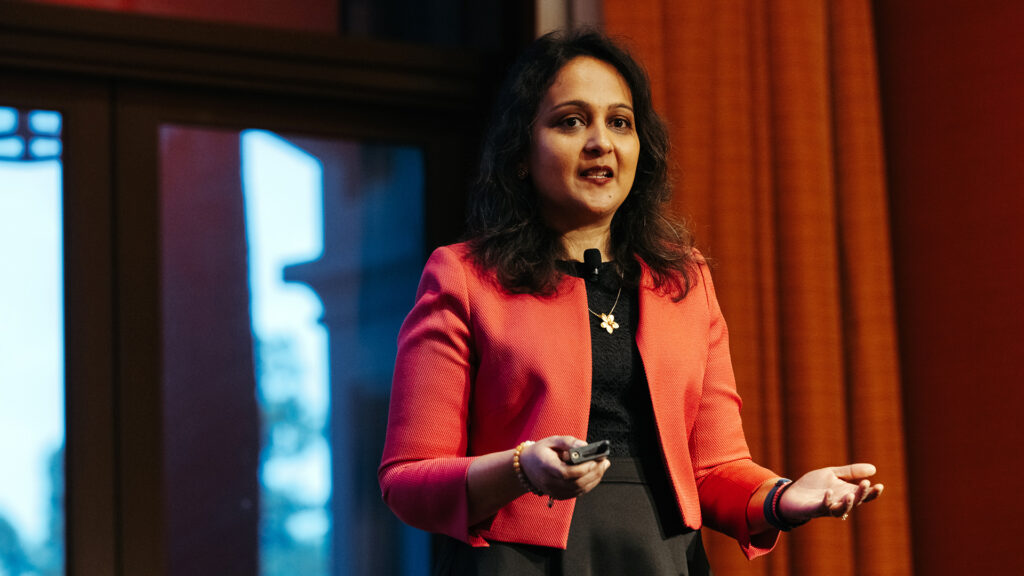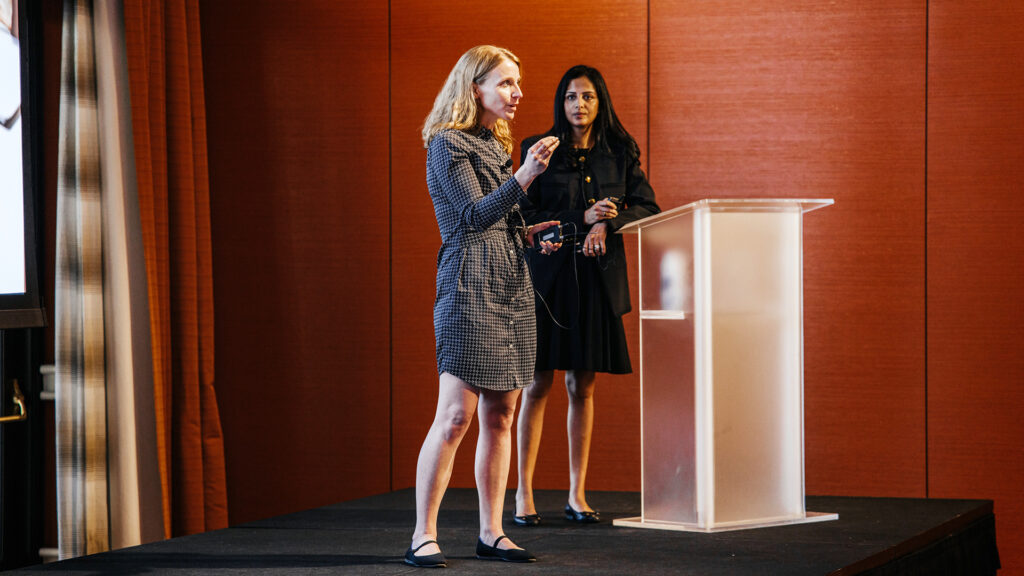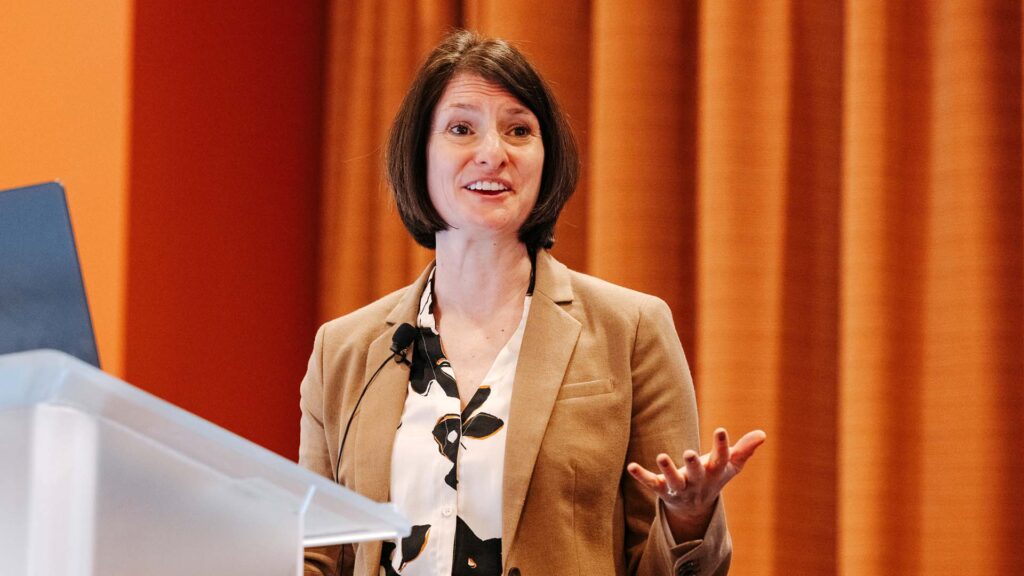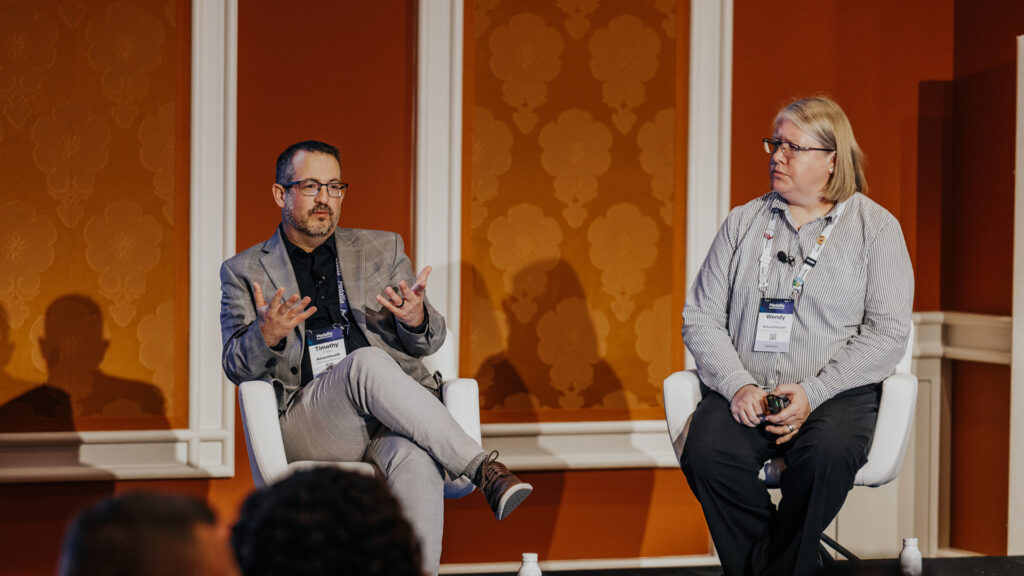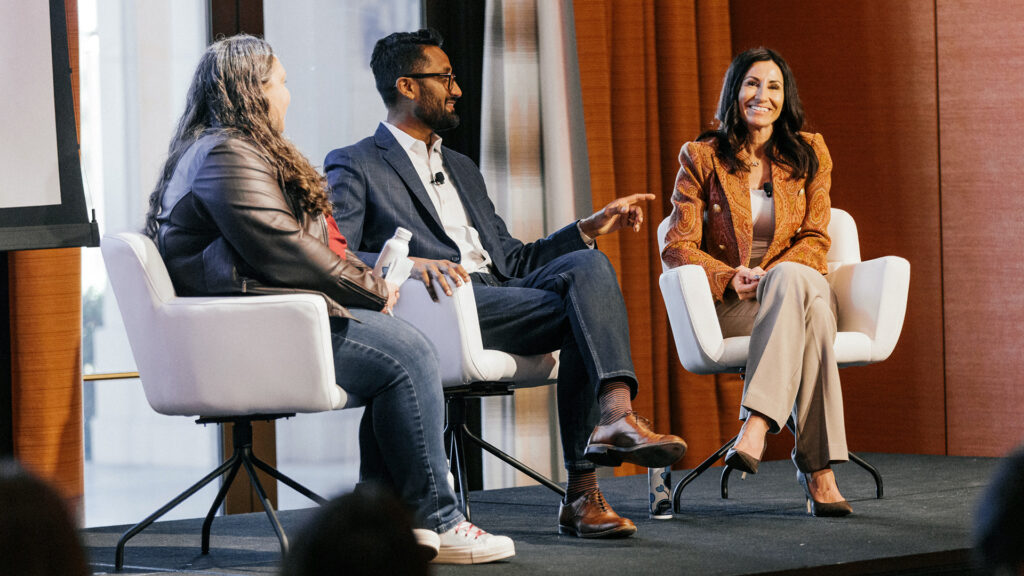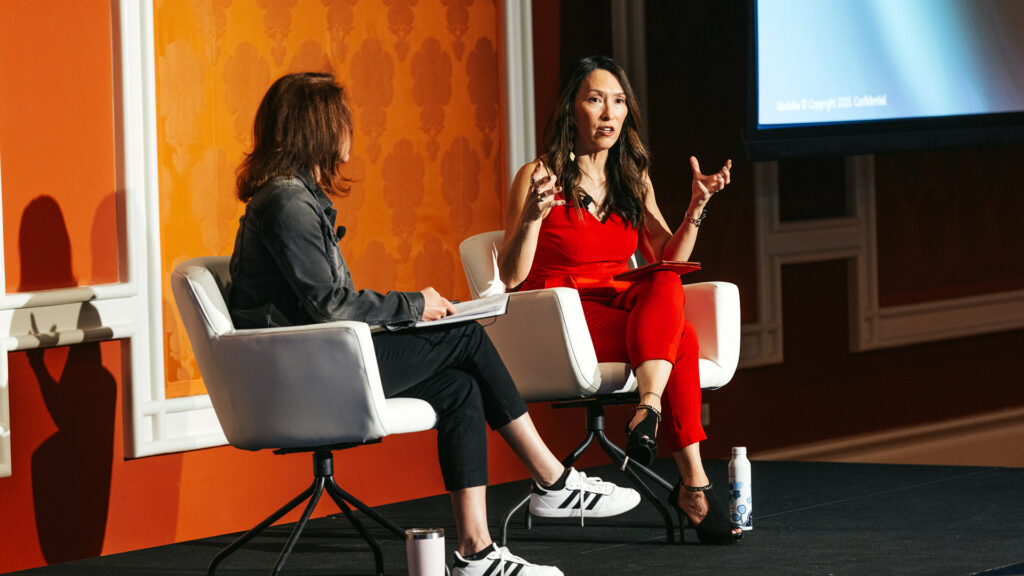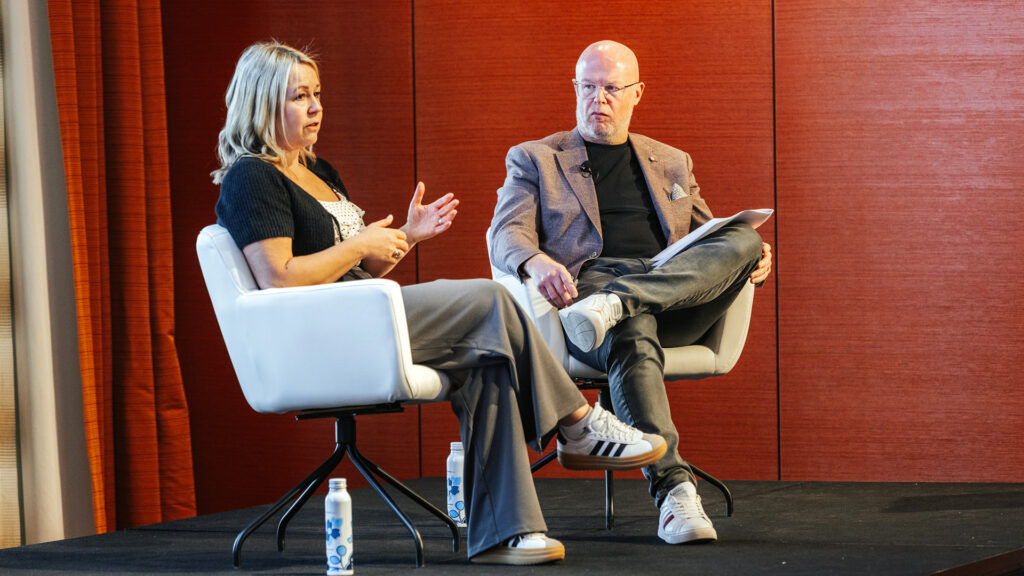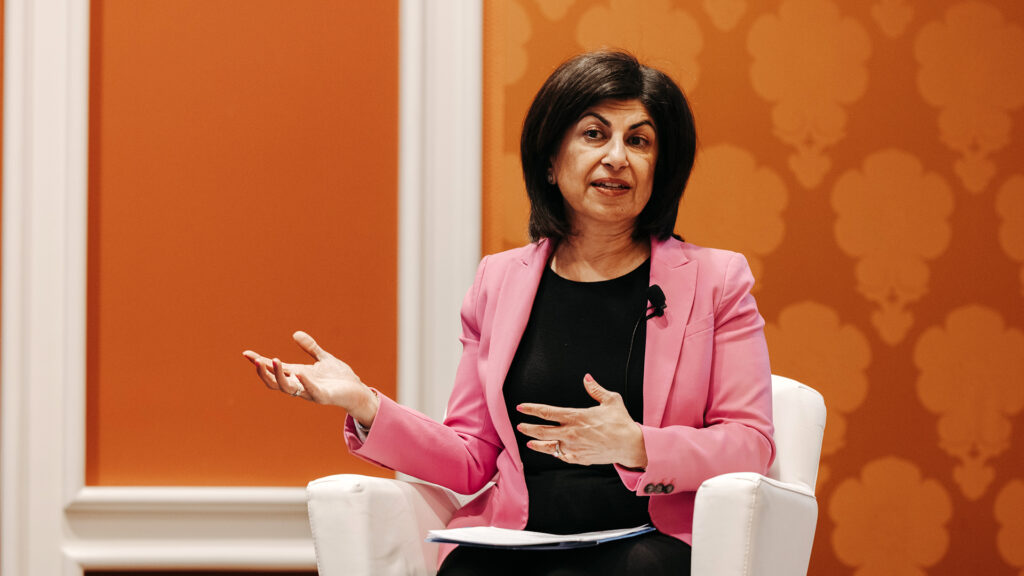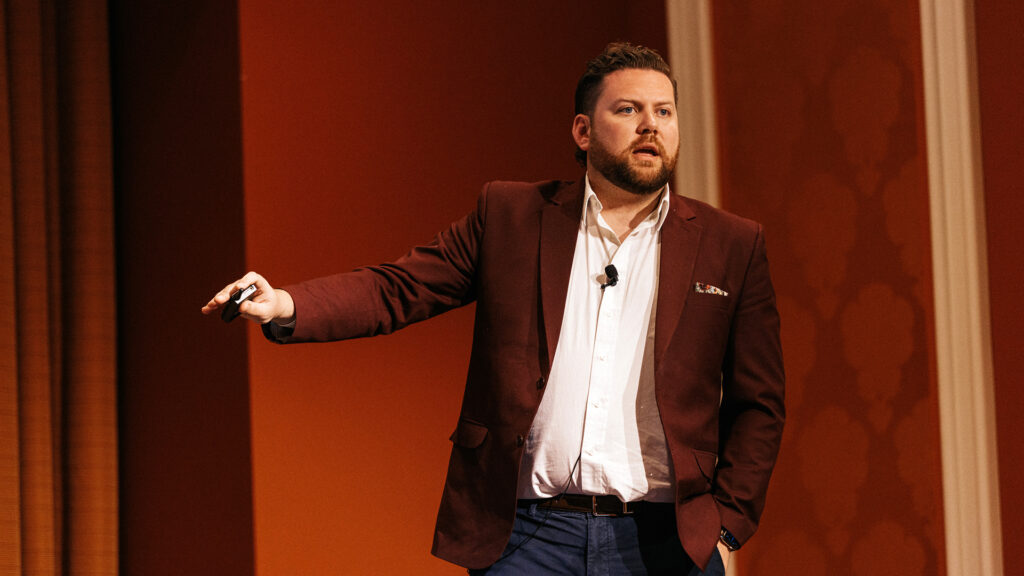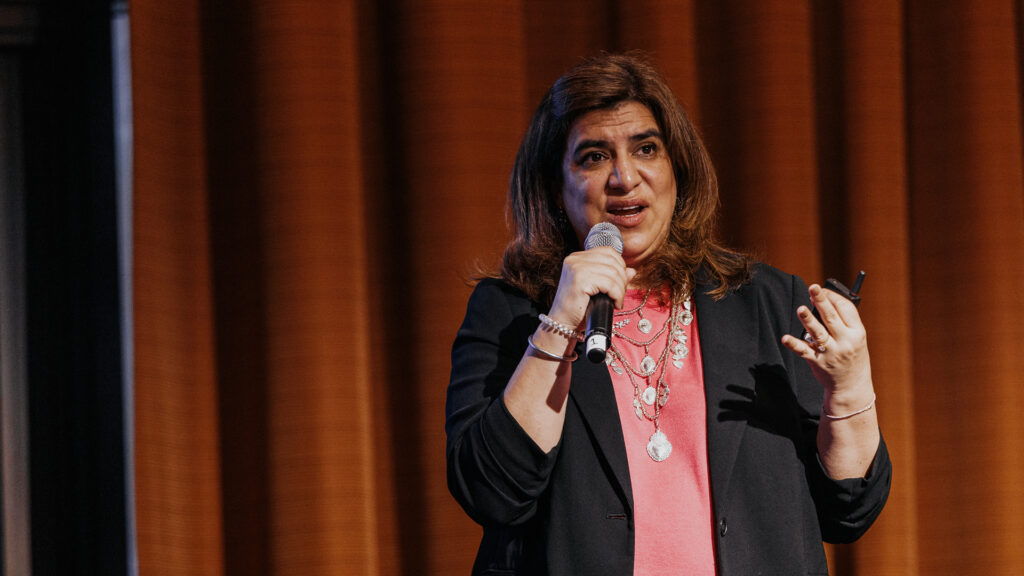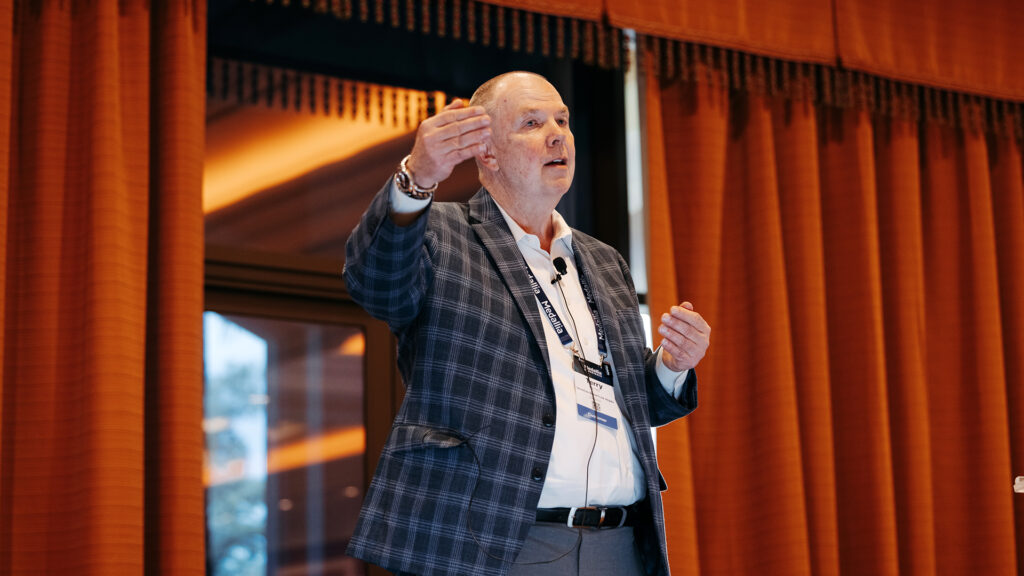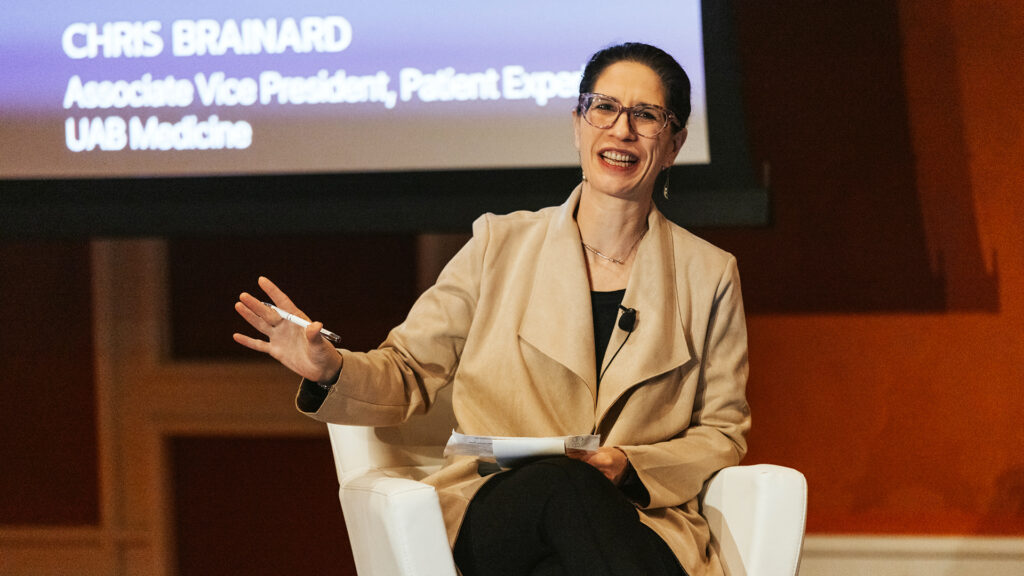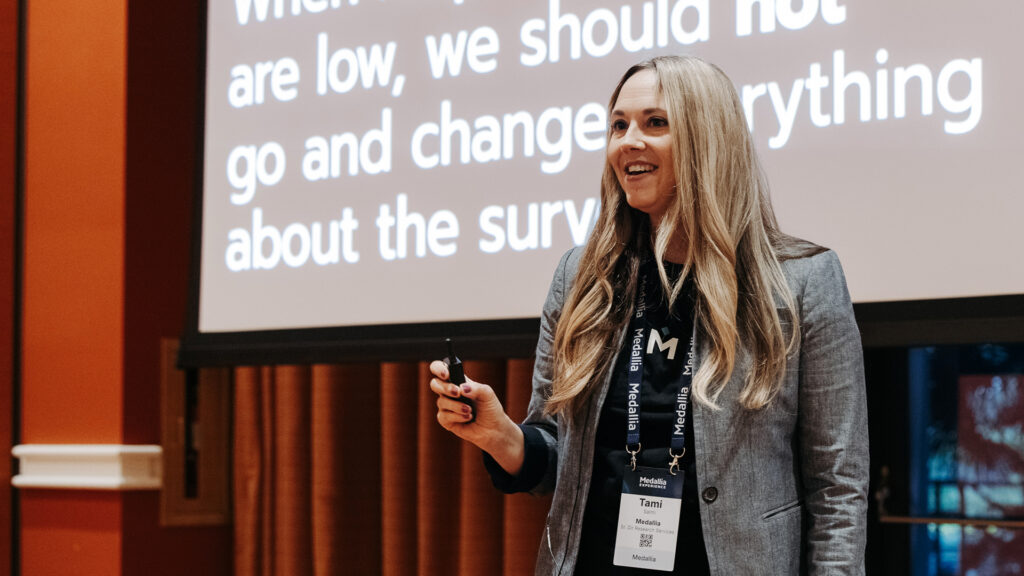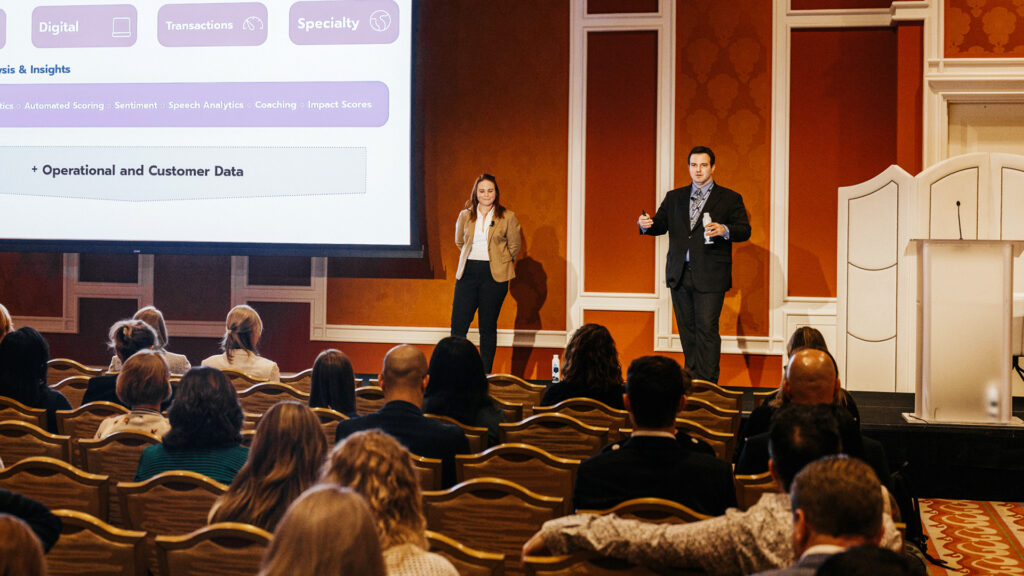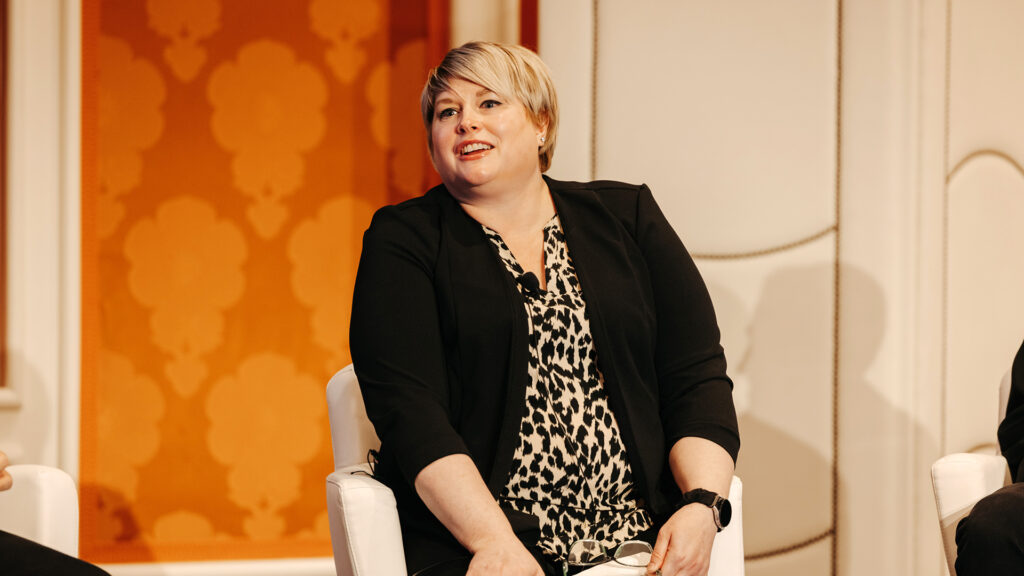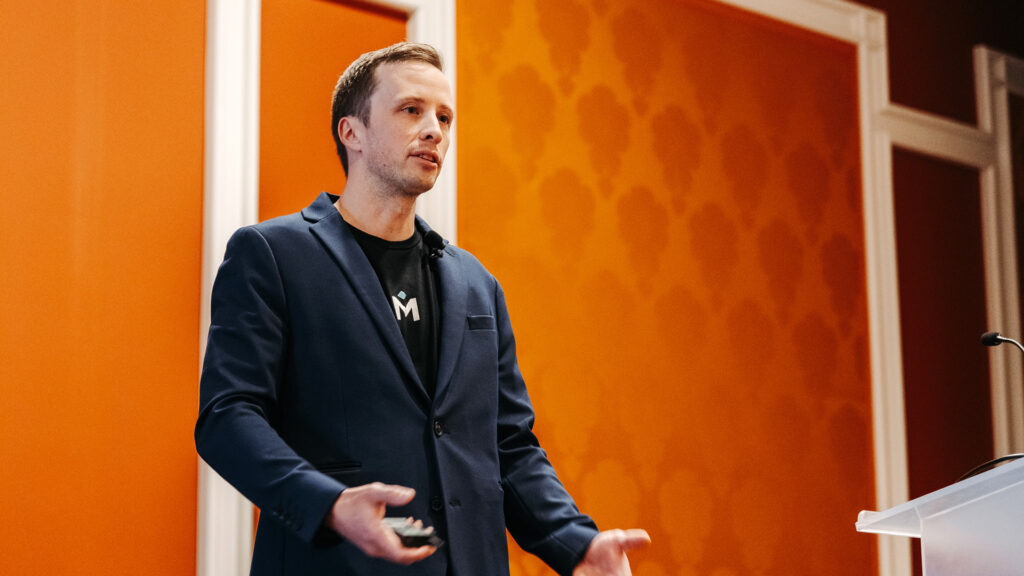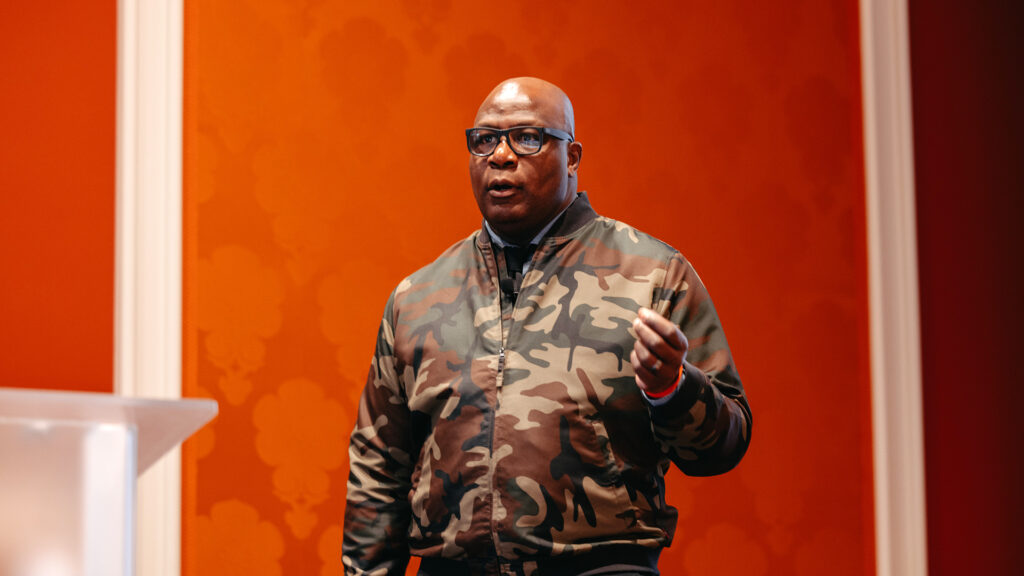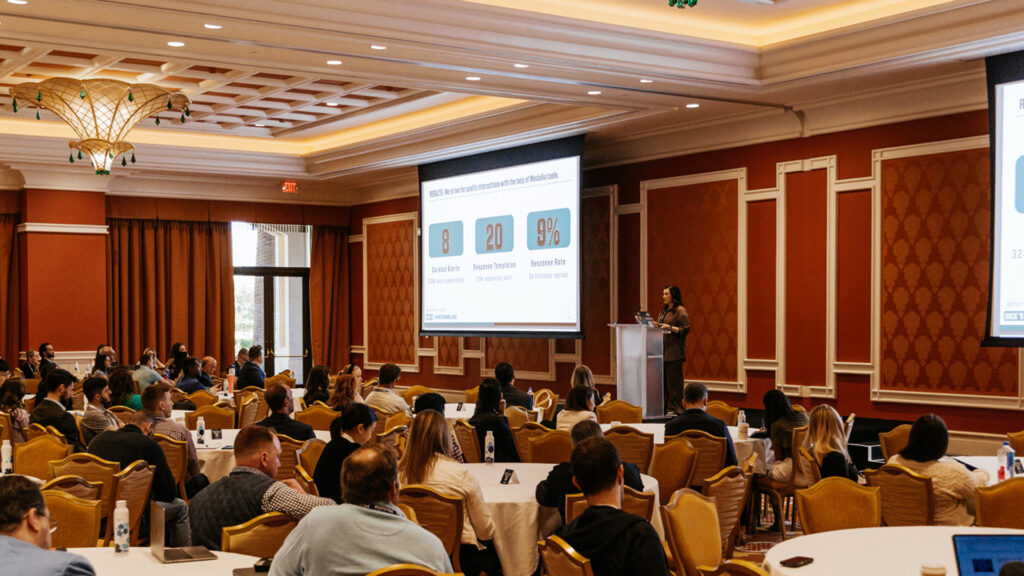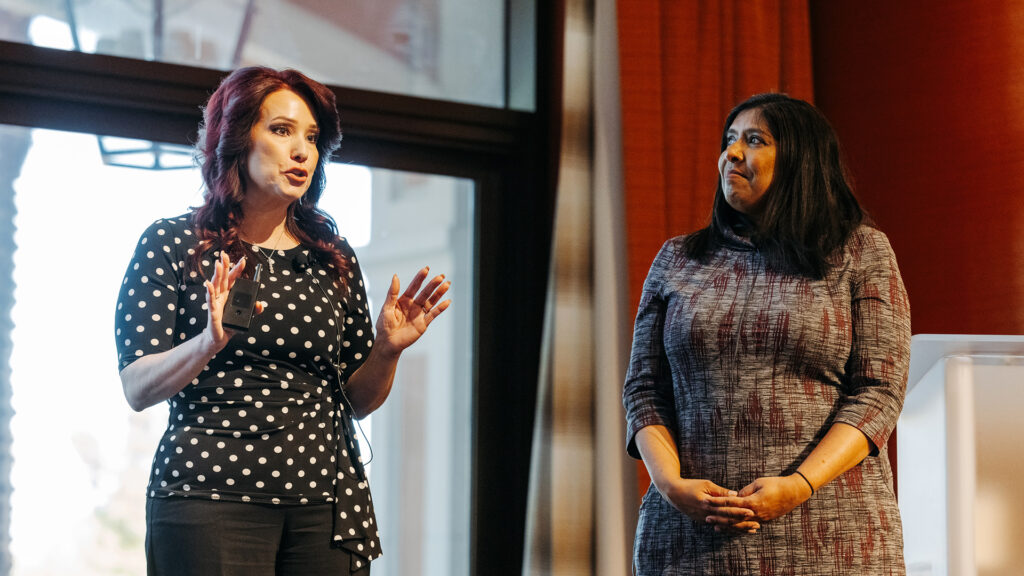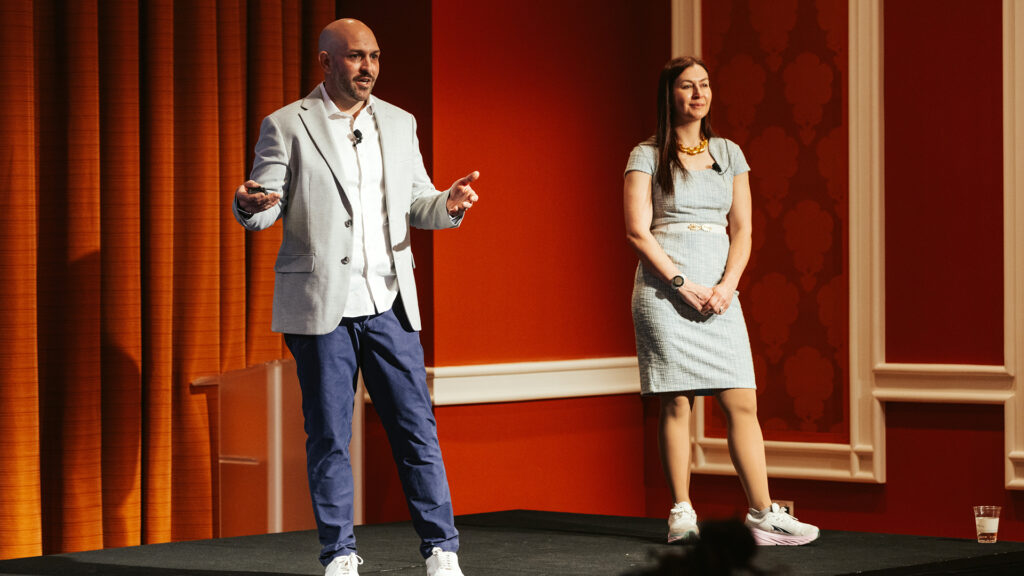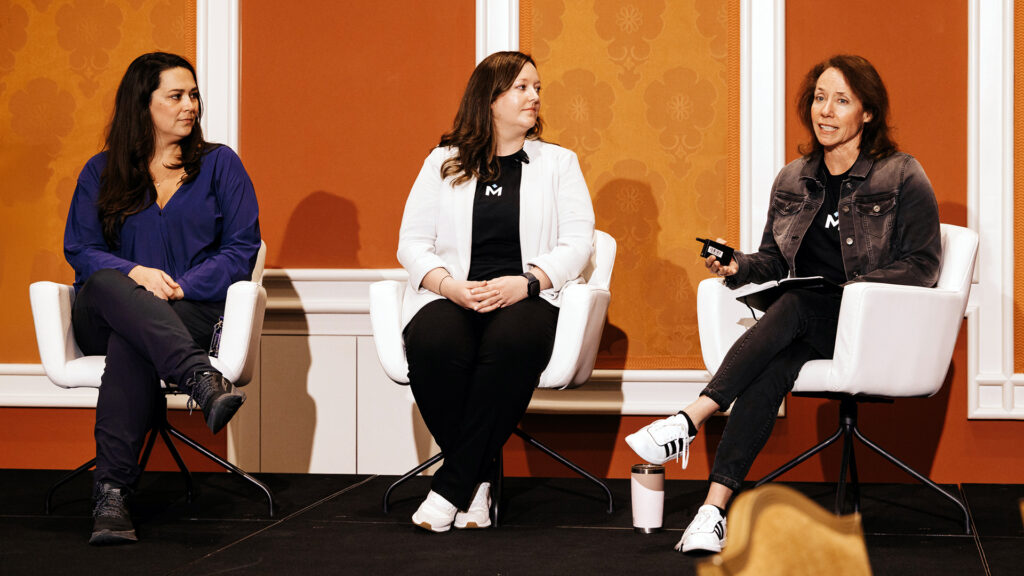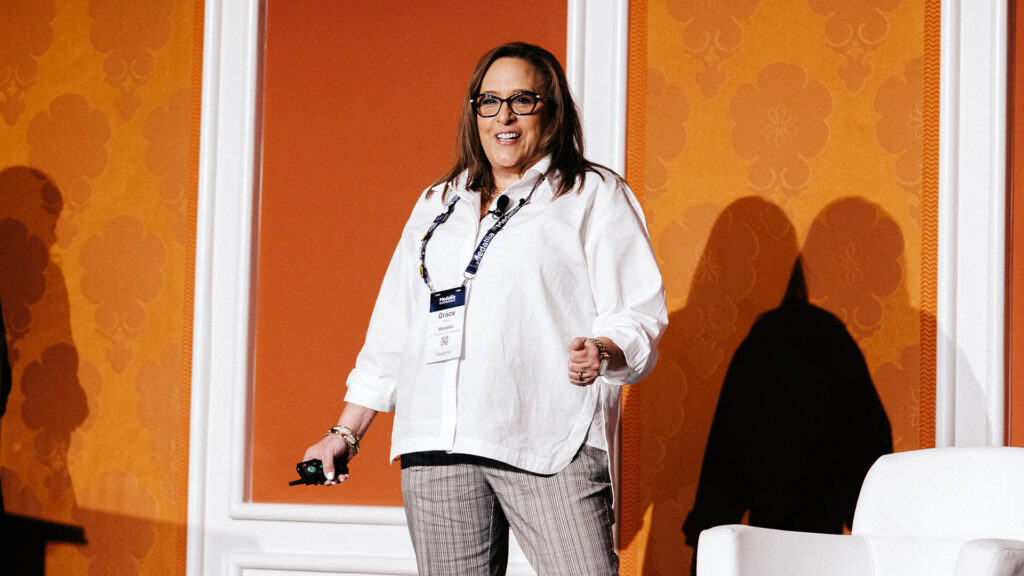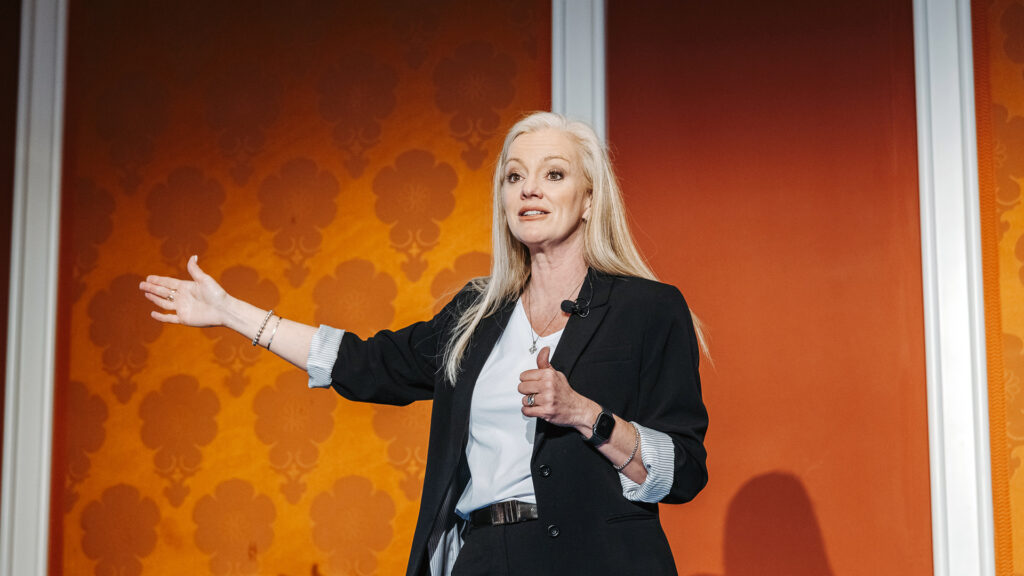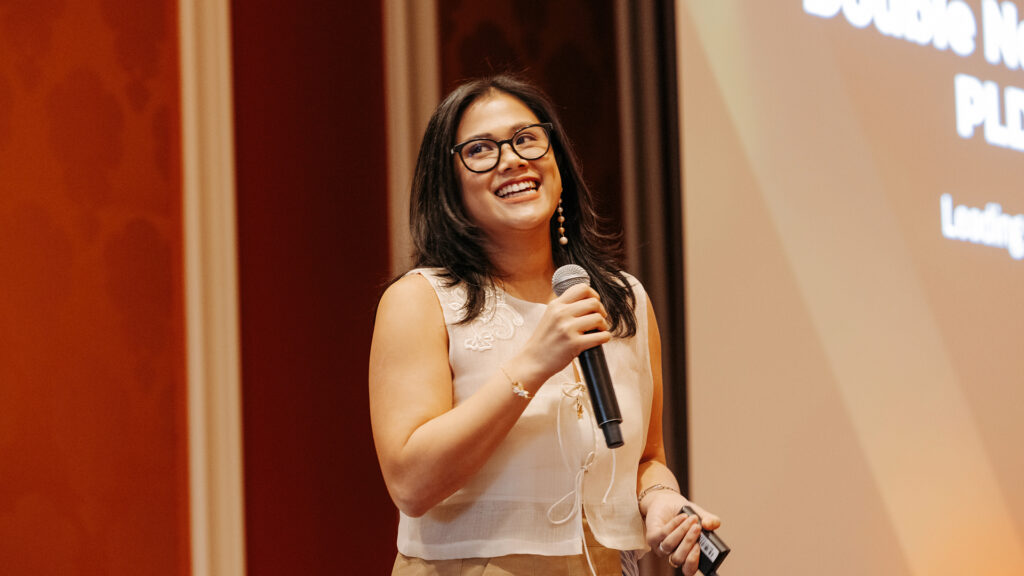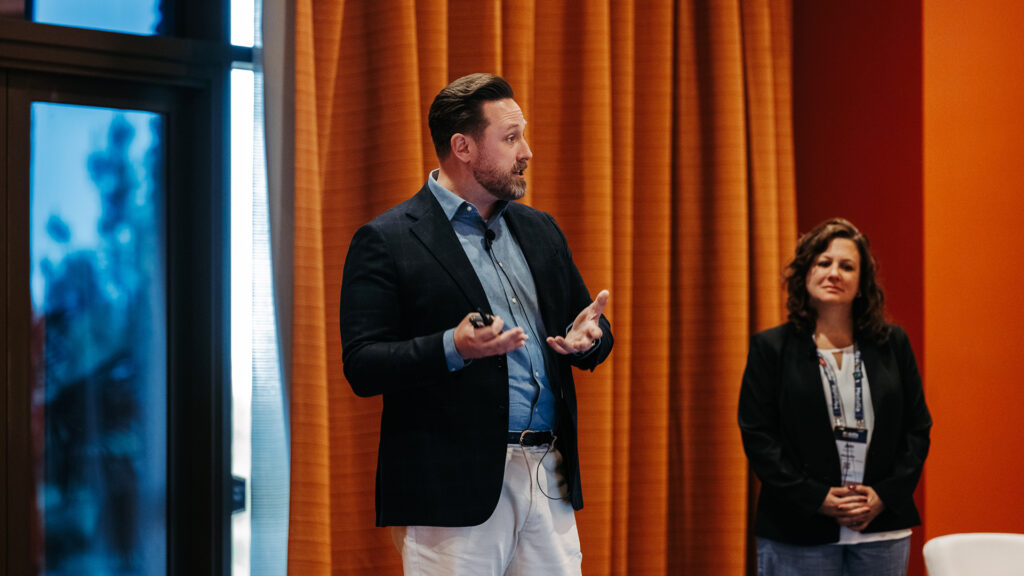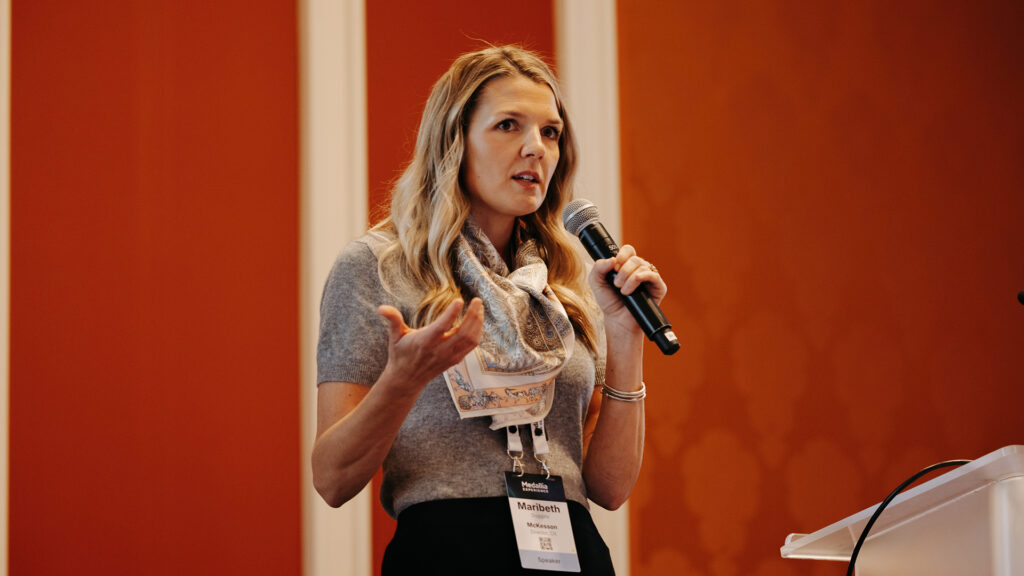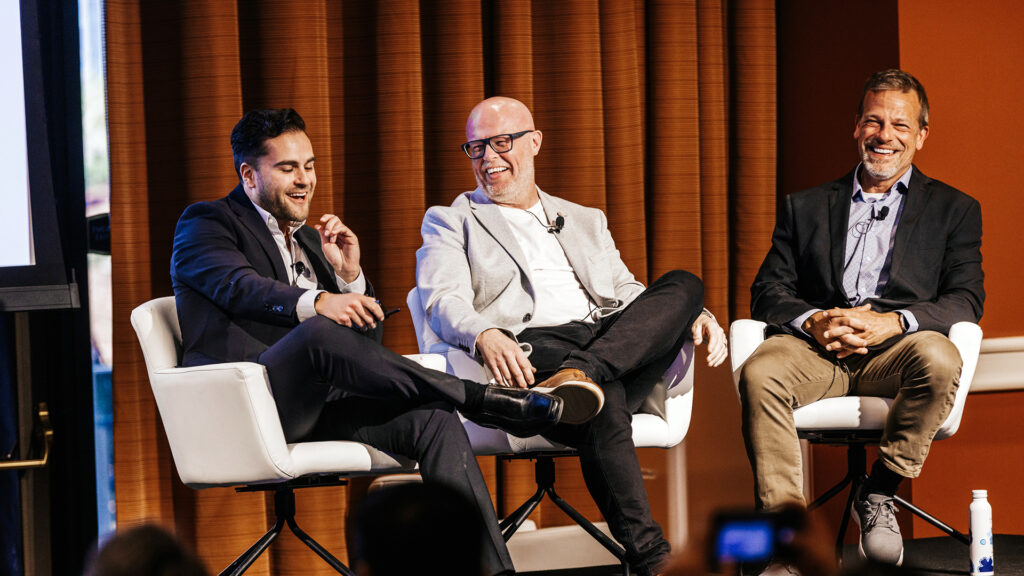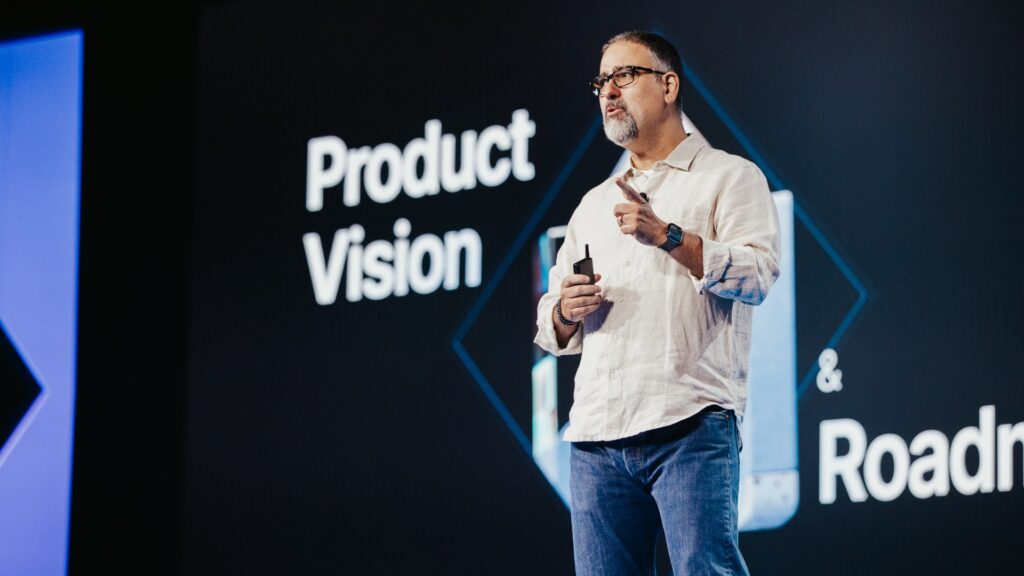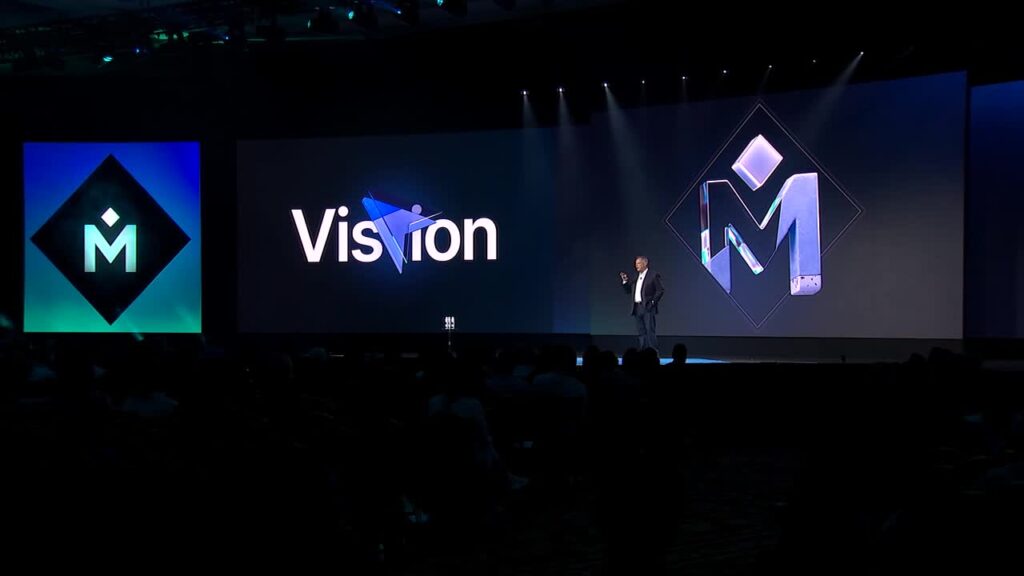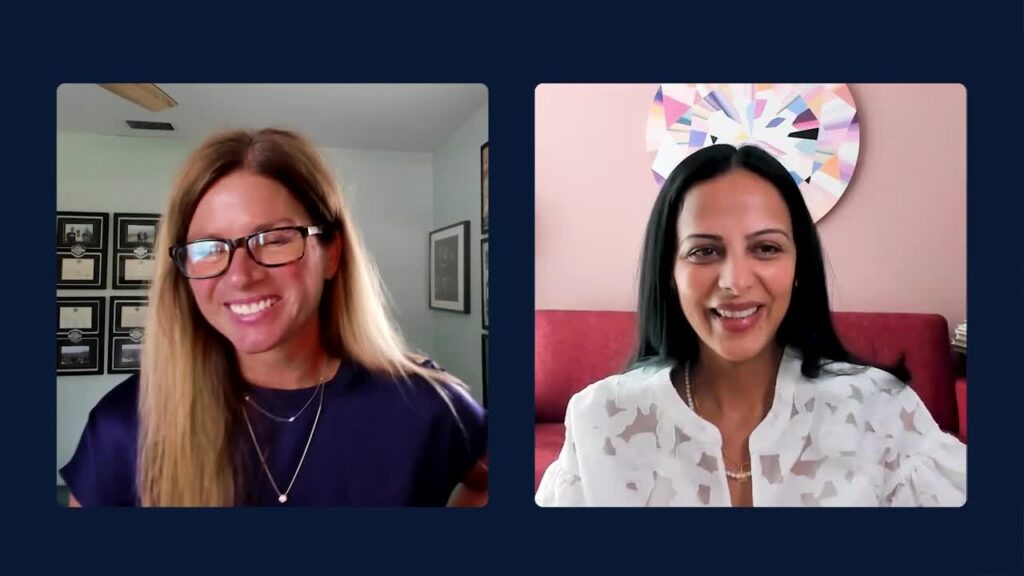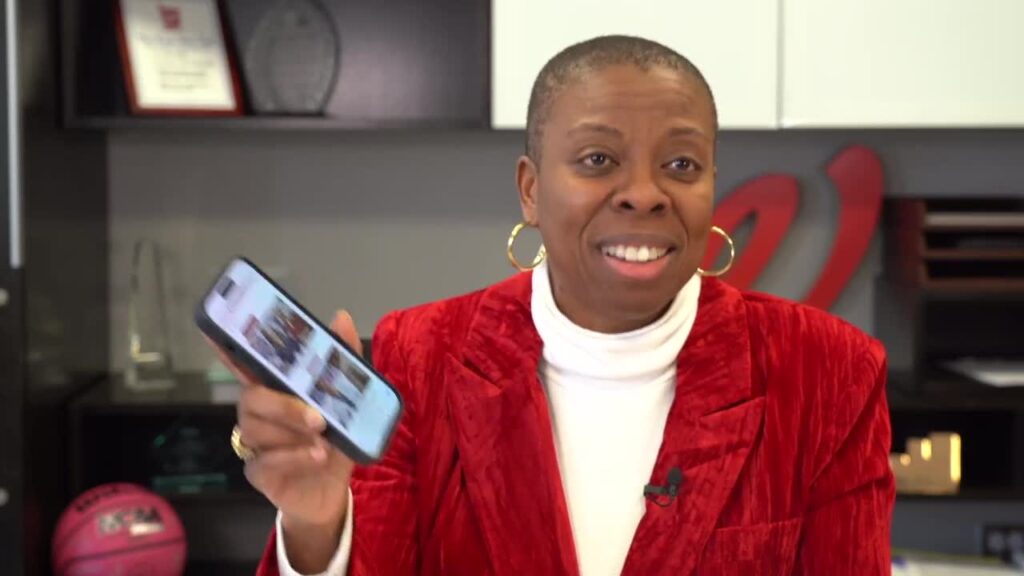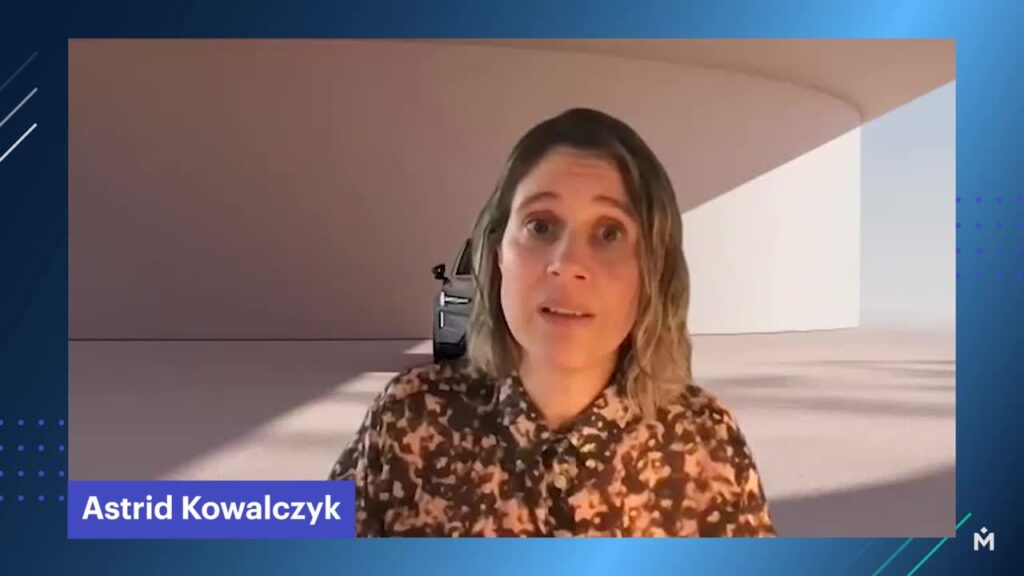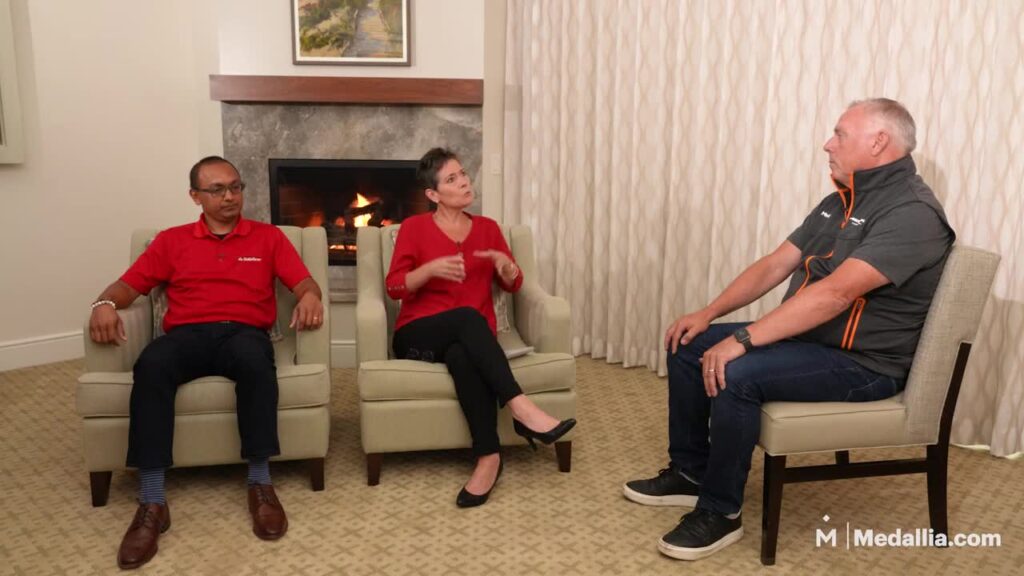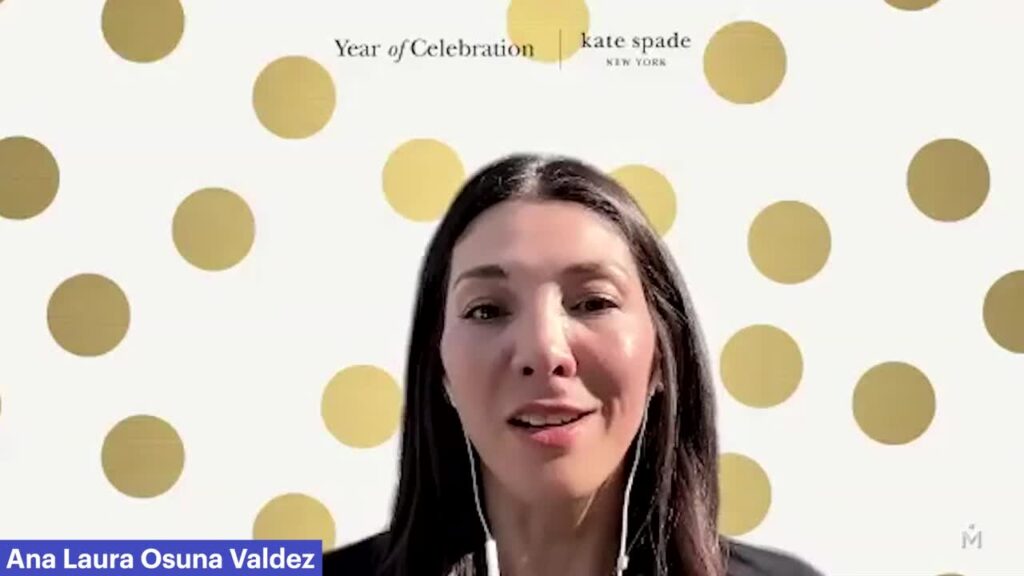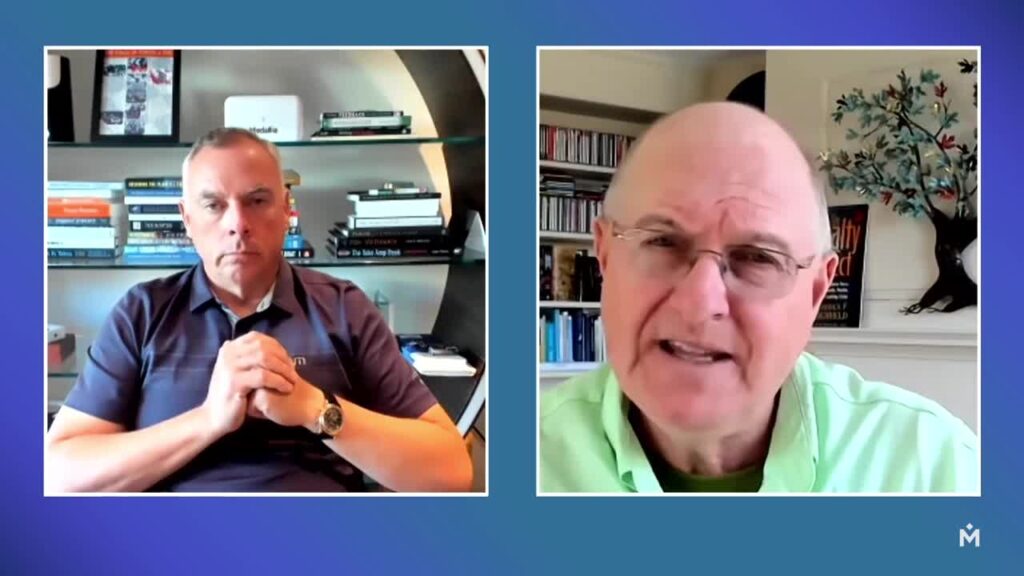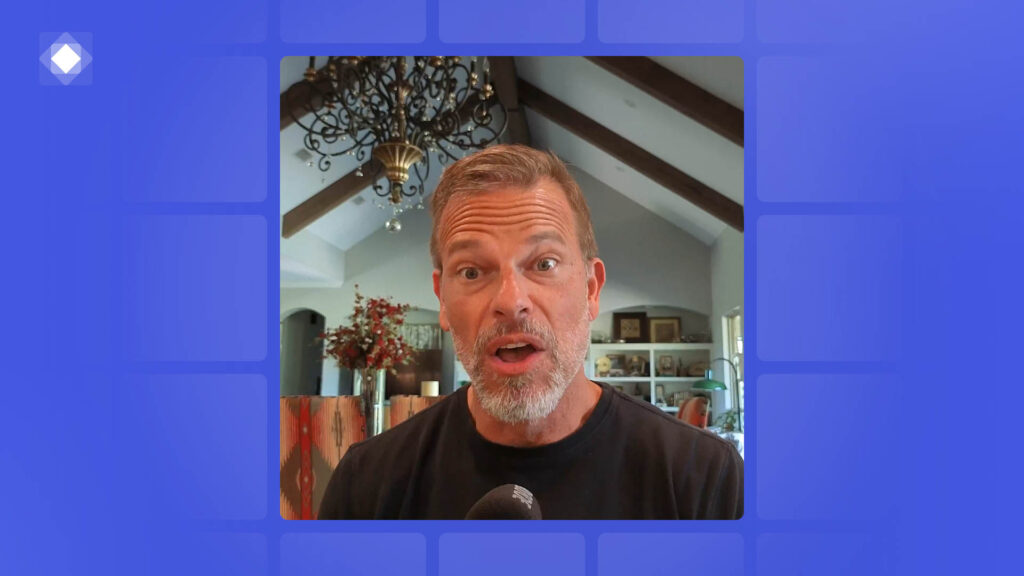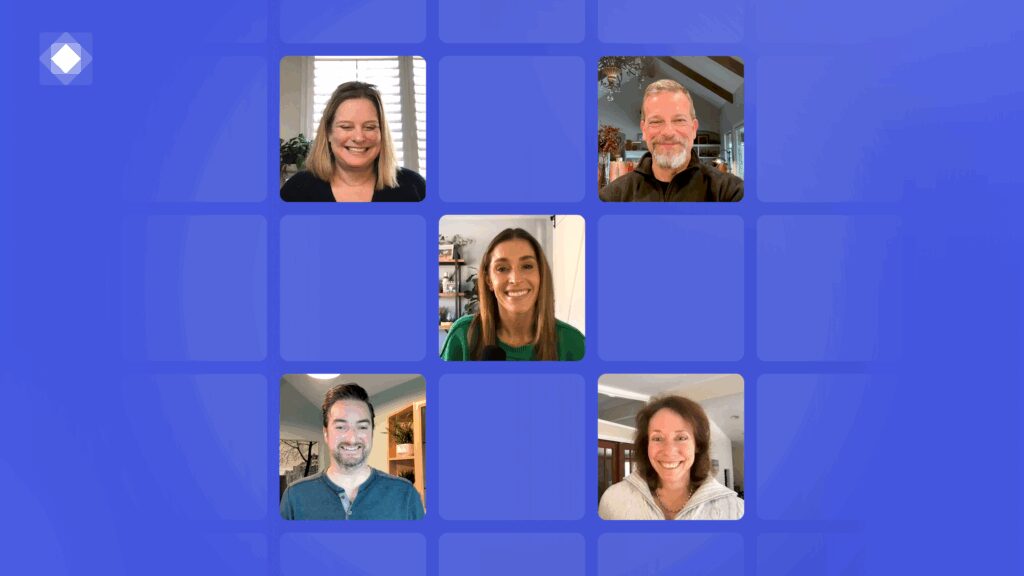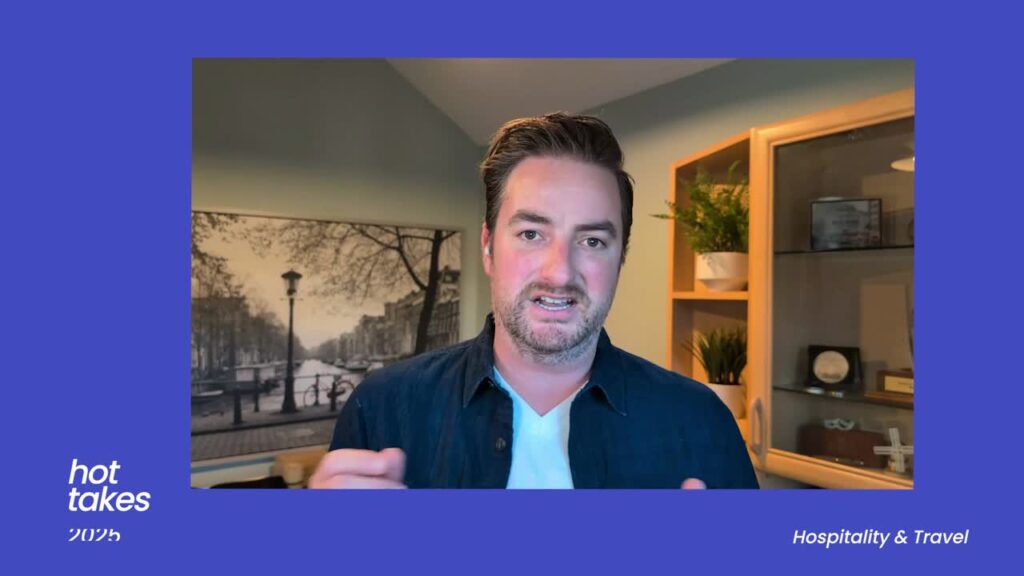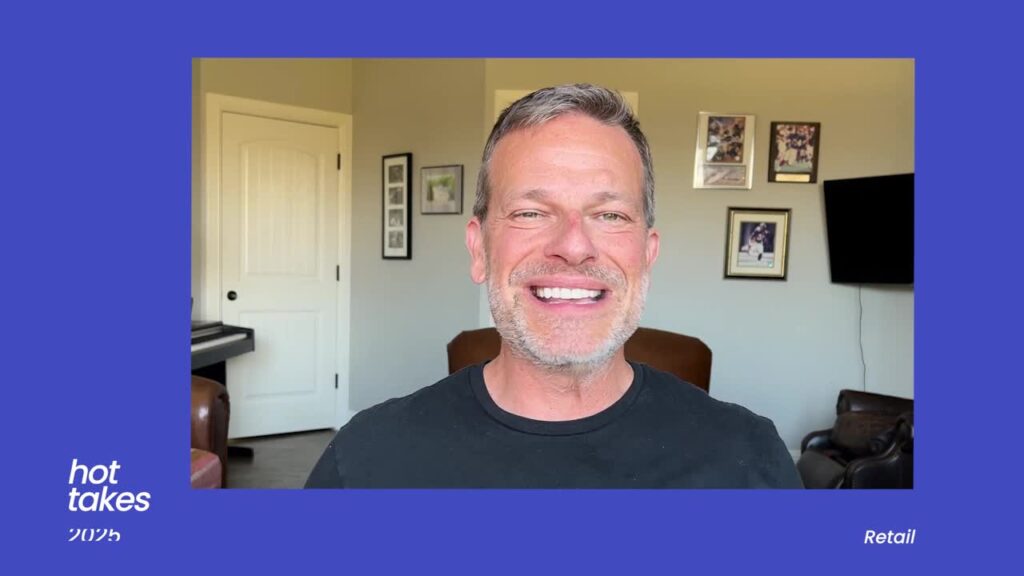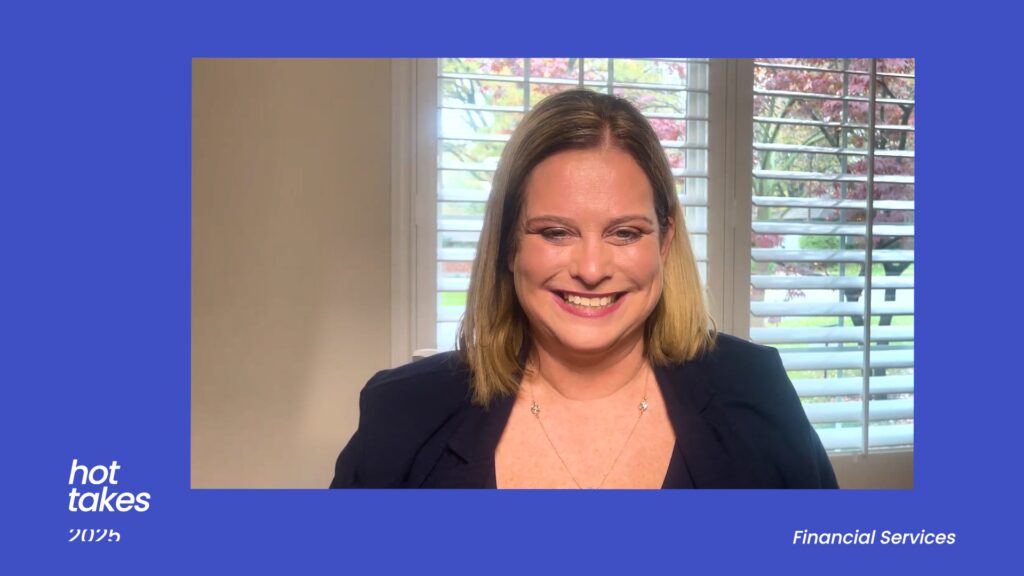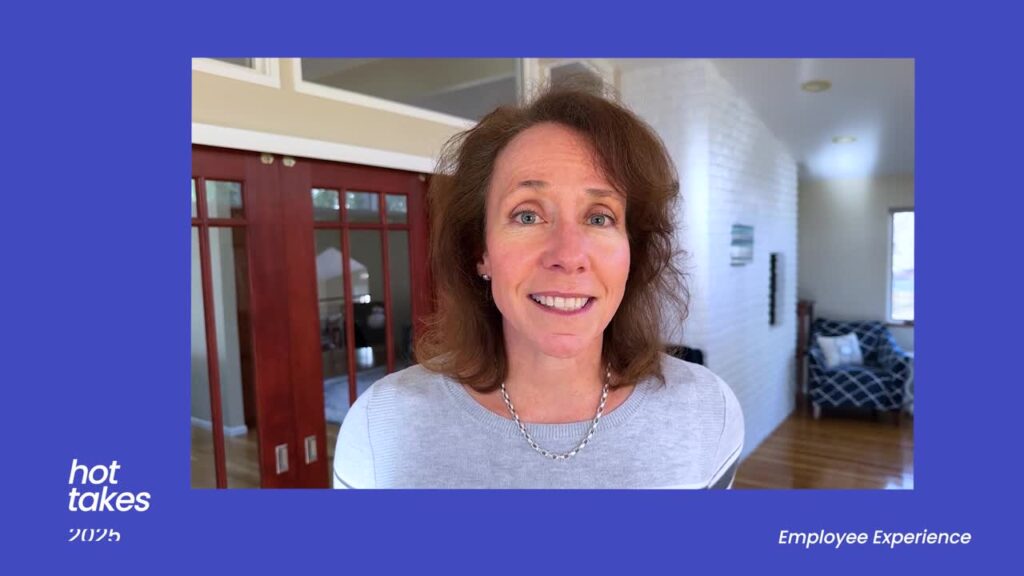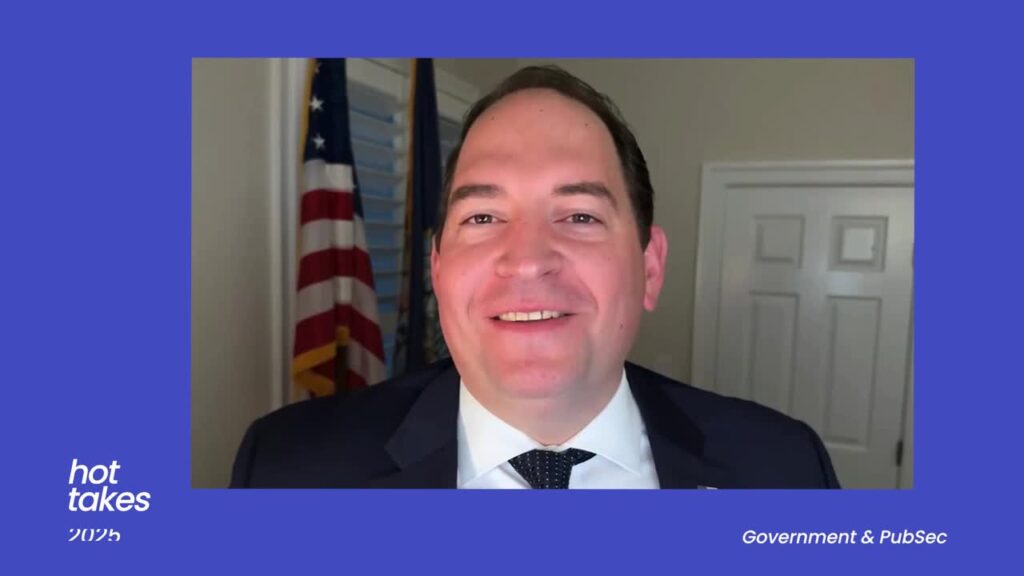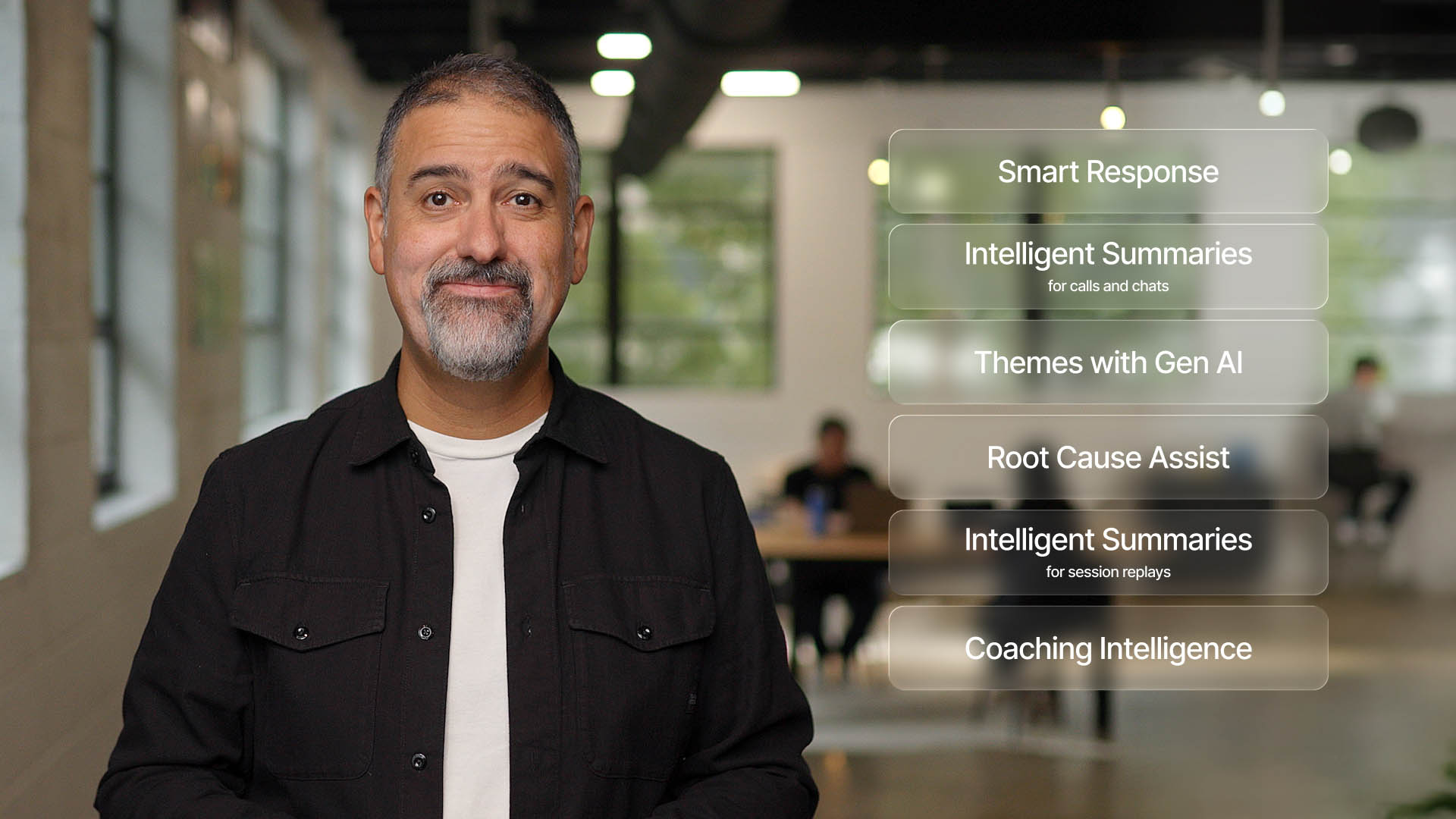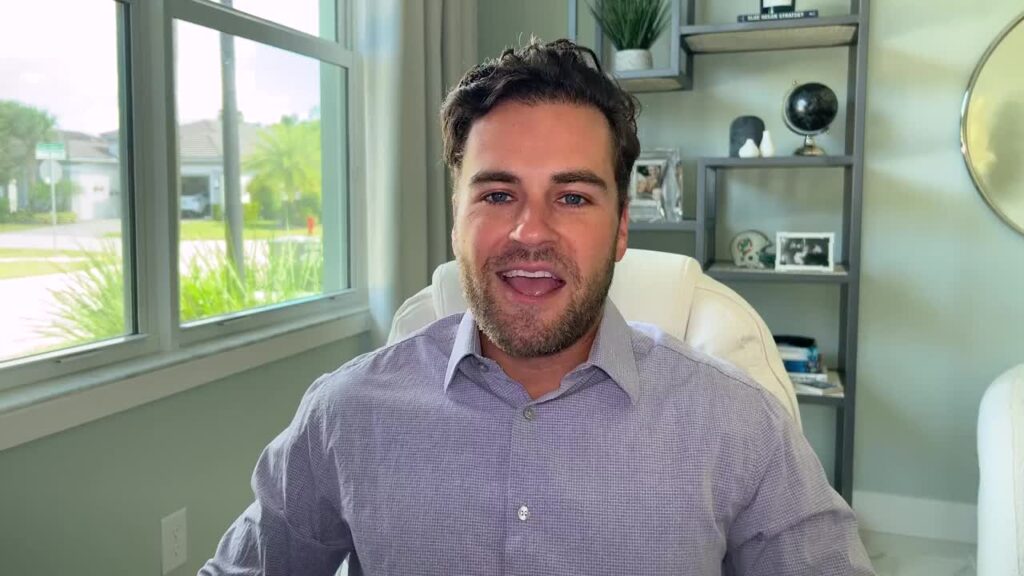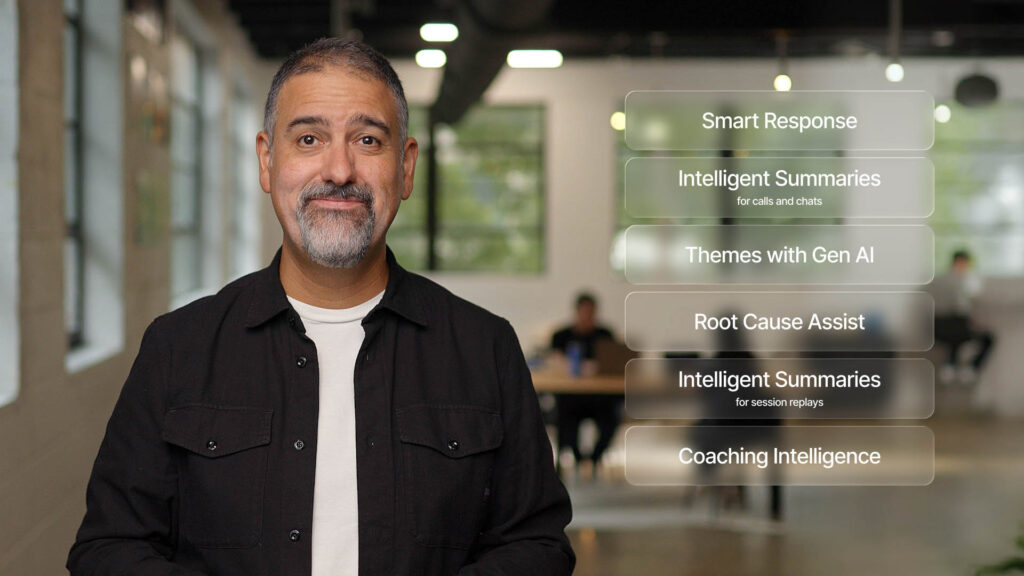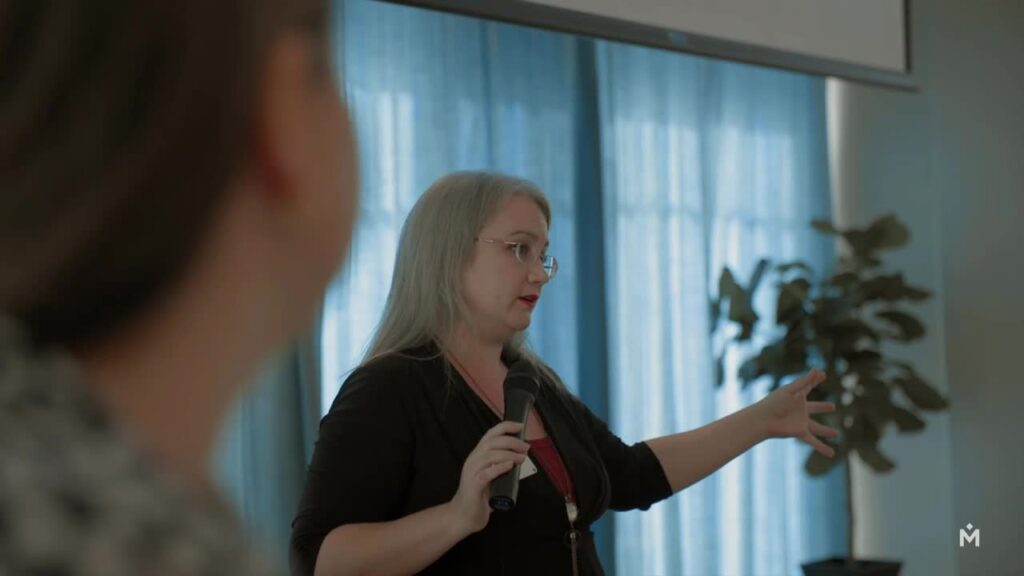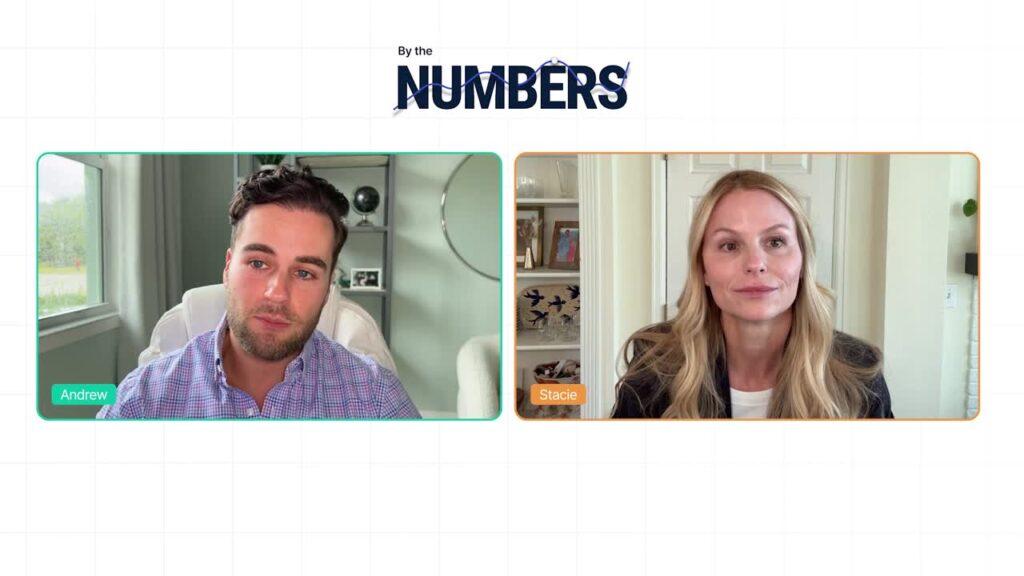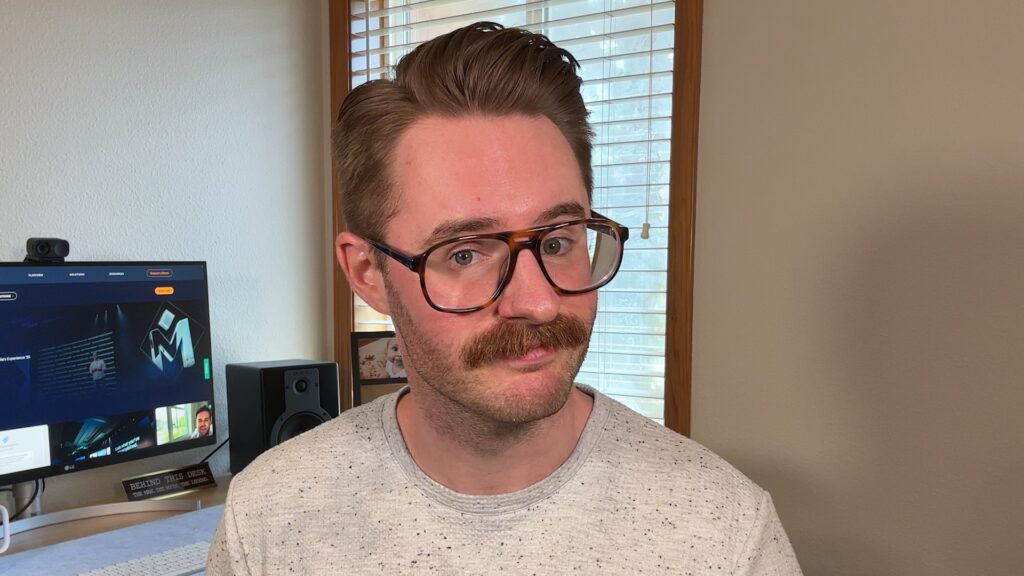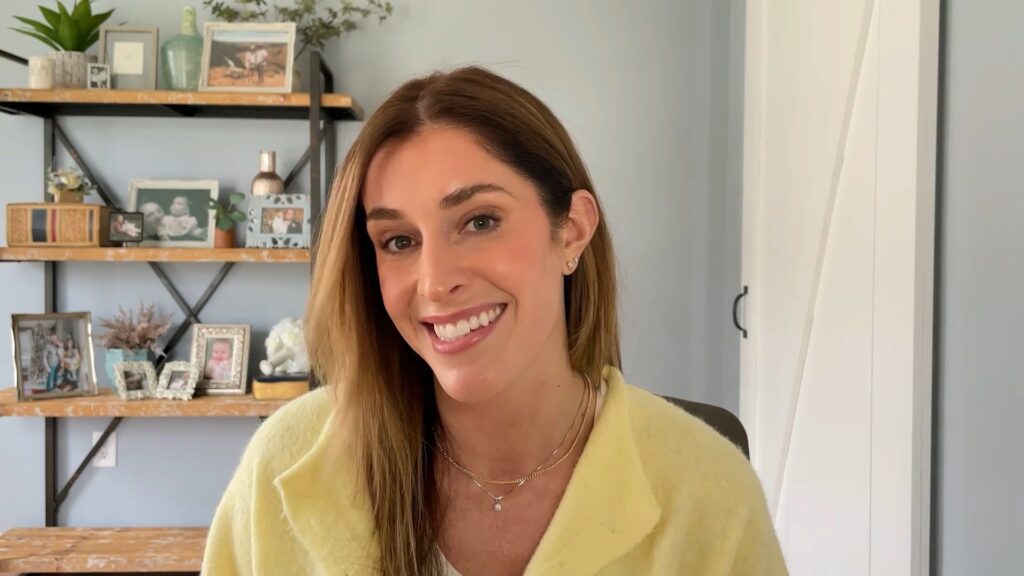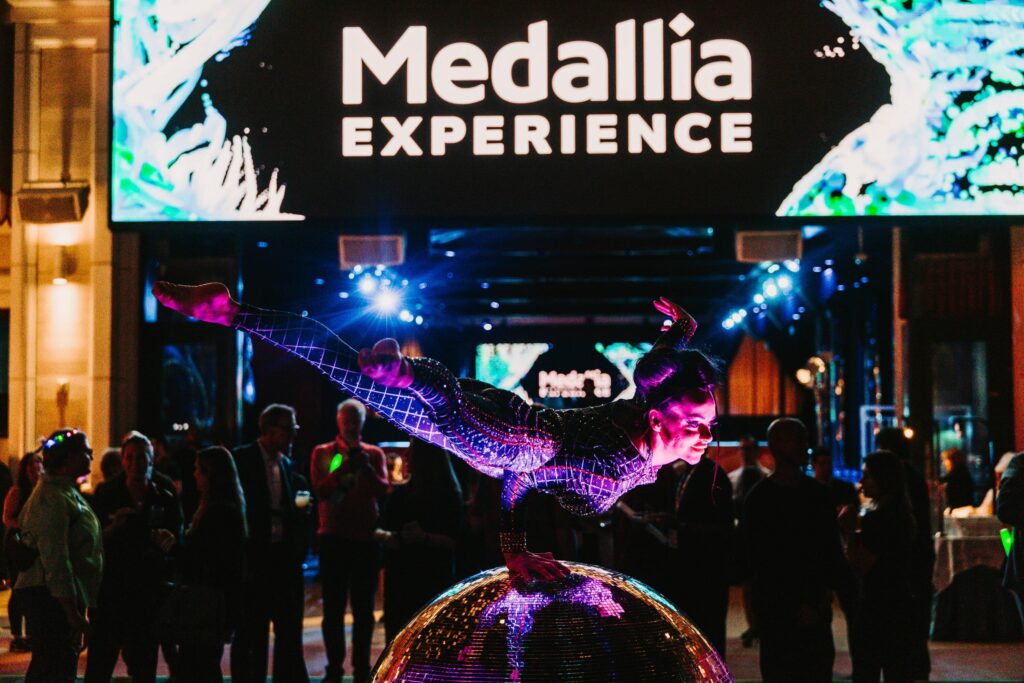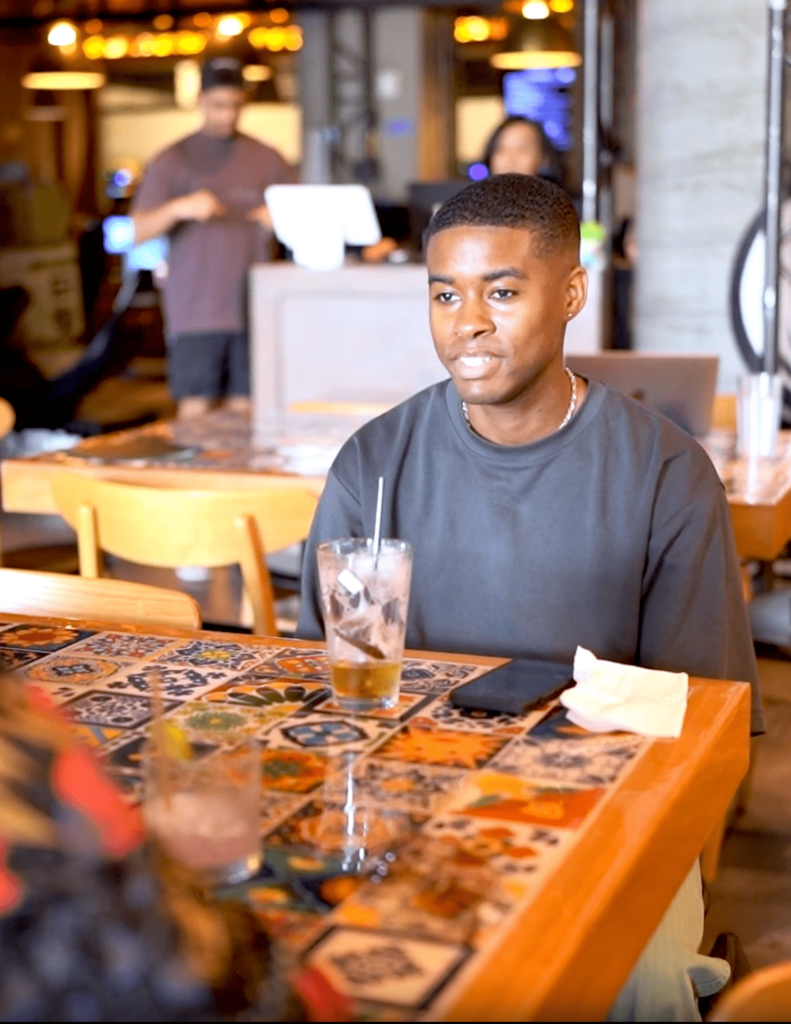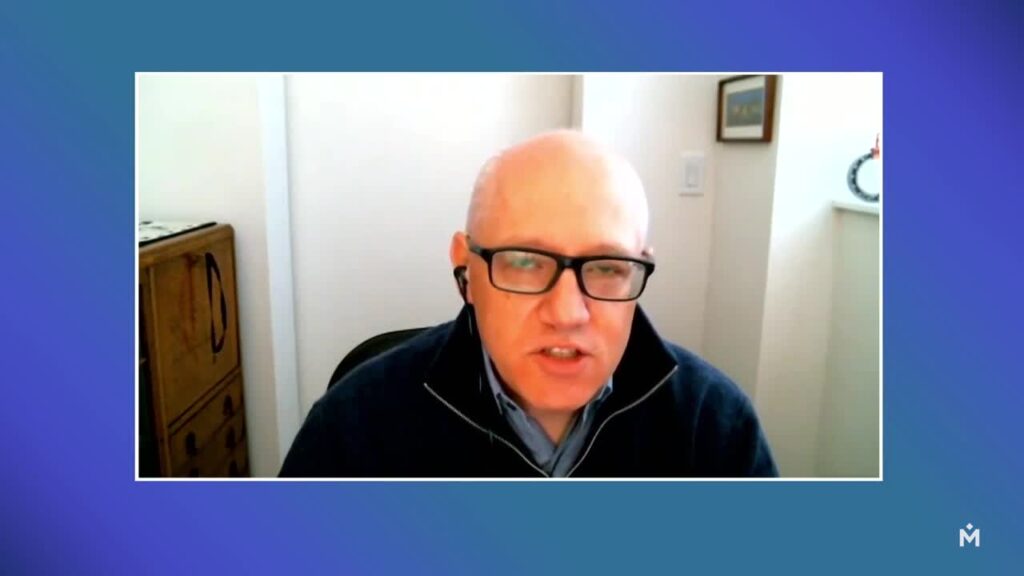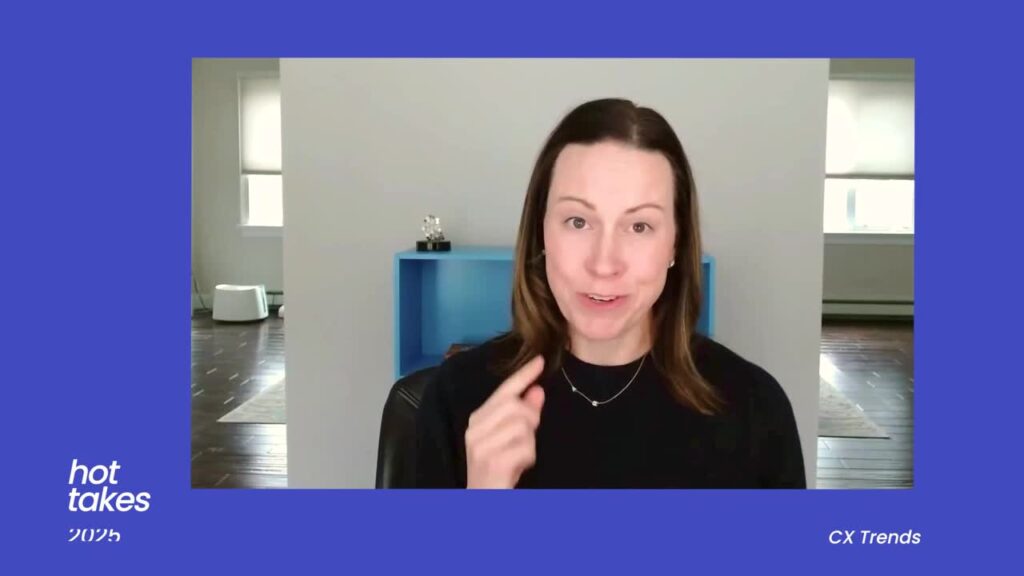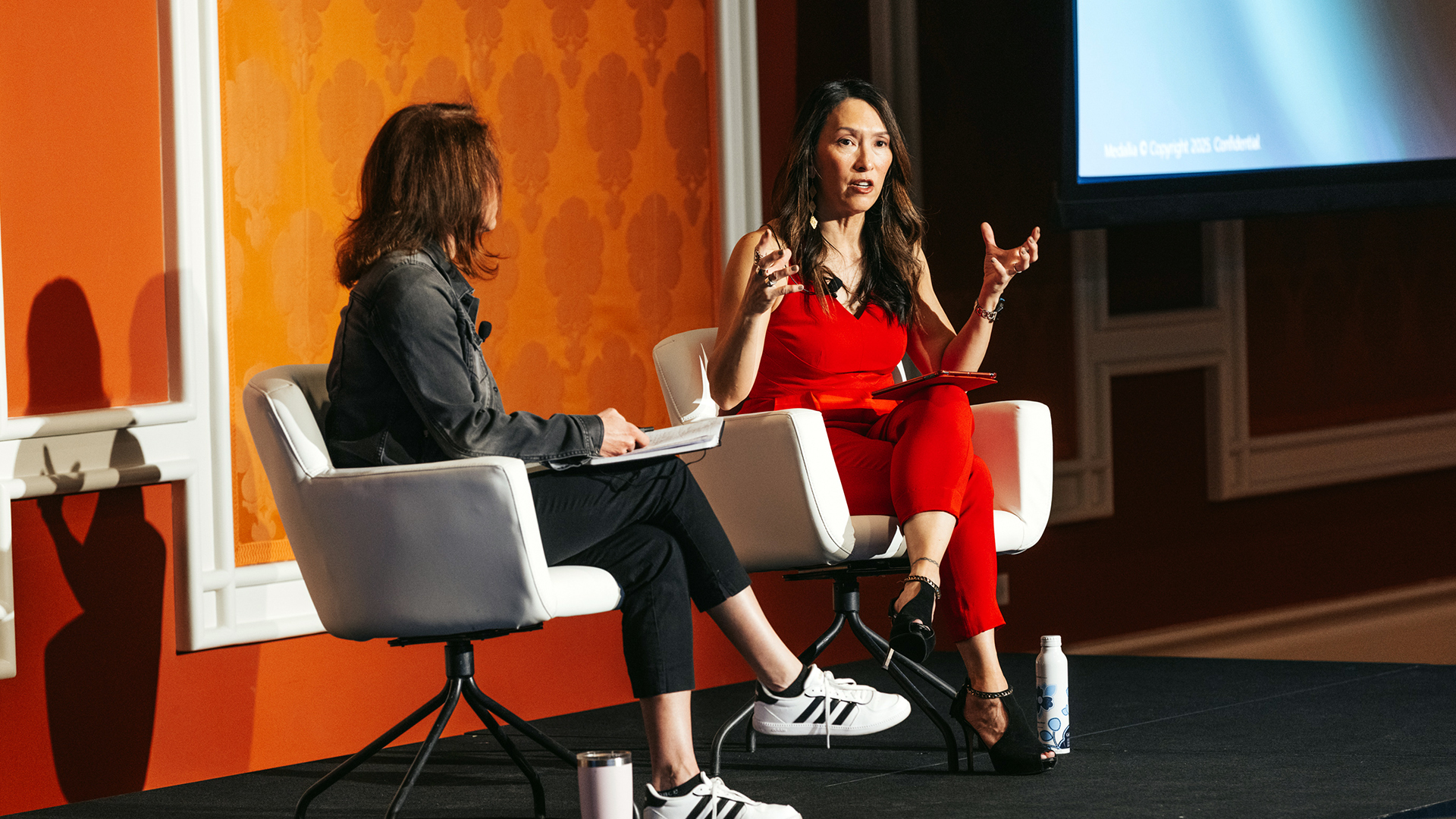Melissa Arronte: [00:00:00] I’m Melissa Arronte. I lead the employee experience practice at Medallia and I’m so excited to have Denise Lee Yohn join me today. I think many of you probably just heard her in the keynote. And our plan is to really be a follow up from the keynote to be able to get to the next level of detail. And I hope you’ll have some questions ’cause you’ll have a nice opportunity towards the end to ask Denise some questions.
But, let me give you a minute to reintroduce yourself. Please.
Denise Lee Yohn: It’s such an honor to be here. I have been working in brand leadership for many years and something that I shared recently was that I really appreciate the opportunity to speak here at Medallia because right these days I go around, I talk all the time about customer experience, brand leadership, et cetera, et cetera, but my time with.
Folks like you is very limited in the sense of like, how are you actually gonna take action on what I’m speaking about? And it’s great to be able to partner with Medallia and be like, okay, so now here’s how you actually activate some things you’re talking about. So thank you very much for
Melissa Arronte: the opportunity.
Yes, thank you. We love working with you, Denise. I remember the first time that Erica brought you to our attention, like someone else [00:01:00] thinking like us and so many of you think so. Thrilled to get to talk to you today. So what I would start with actually is the basics. Like just talking again about how we define EX and how we’re broadening that definition.
So how do you define it?
Denise Lee Yohn: It’s like customer experience, right? It’s the sum of all interactions that someone has with your organization. This case just happens to be an employee, so everything an employee. Sees and hears and touches and feels, taste, smells, whatever. It starts from the moment that they become aware that you even exist as potential employer, all the way through all the stages, steps, interactions, transactions, all the way to the end of employment and even after employment with a lot of the alumni networks and other.
Experiences that we’re now seeing pop up. I agree
Melissa Arronte: with that. And one of the other things I think that I read about in your book is about connecting it with business outcomes. And so the purpose of EX isn’t simply to have a great place to work, while that is one component, that piece as you talk about, is easily replicated by other [00:02:00] companies.
And so having it associated with. Business outcomes and what the company’s trying to achieve, I think is critical in how we think about ex.
Denise Lee Yohn: I come from the San Francisco Bay area and so there are lots of tech startups and they all want to have these really cool offices and. Cool experiences for employees.
And there was one particular company who will not mention that, had this whole like wellness aspect to what they were trying to create for their employees. All very good, all very well intentioned, but like their brand was about social sharing. And it was like, what do these two things have to do with each other?
And at the end of the day, how are you setting up your employees to be successful? And actually. Producing the results for your organization. Exactly.
Melissa Arronte: The summary of the definition here on the screen, but I think it’s also helpful to define what EX is not. I think there’s a number of components that people often think about ex that gets them boxed in.
So what are some of the things you’d say ex is not?
Denise Lee Yohn: Yeah. I talked about this a little in my keynote. I think that the first thing is just to jump to tactics and think [00:03:00] about, okay we’ll, how can we just make a. HR better, how can we do surveys better? How can we measure performance better?
How can we do talent acquisition better? Like all these things. And yes, those are all parts of employee experience, but employee experience is so much more. There’s so many more touch points, interactions, whether it’s facilities or IT or communications or marketing, and all of those things need to be orchestrated into a seamless experience for your employees.
Just like most. Companies work on a seamless experience for customers.
Melissa Arronte: I think you’re right with that. One of the things I think sometimes happens with some HR teams is they get so focused on the HR outcomes. So there was a people analytics leader I was talking to, it’s very focused on thinking of treating employees like customers, and I thought, wow, we’re really well aligned.
Then he talked about his most recent project and it took over six months and his whole team, and they did journey mapping of the performance review process, and the end was real result was they took one step out of it. So that did make things easier for people, but that was an [00:04:00] incredible amount of work for something people only do once or twice a year.
And really focusing on was that the top obstacle that employees were facing in getting their work done? And so that’s why I keep focusing on the business outcomes. What was that aligned to? Taking out the one step was, slightly more convenient, but being able to impact the ultimate sales revenue.
Cross sell, right repeat sale. Whatever it might be is really what we’re looking for in EX and is what employees want. To deliver. So what kind of shift in the current thinking about EX do you think is needed for us?
Denise Lee Yohn: Yeah, and it’s interesting being here at experience because I’m like trying to by osmosis, pick up what other people are seeing or feeling thinking about ex.
And I think there’s a temptation to think that EX is just a part. A CX or it’s one more thing that you have to add to your CX checklist. Whereas I think, Melissa, you and I would very much agree that no ex is the foundation [00:05:00] for a cx. You really can’t do cx. Without ex as customer experience professionals, you really do need to be responsible for ex, even if that’s not in your official job function.
Melissa Arronte: The other thinking that keeps occurring to me is I hear a lot of people talking about surprise and delight or a great customer experience, right? A great employee experience. And what I keep seeing in that is it’s so general, like it’s hard to understand what it is we’re trying to execute on as employees.
I think about, for example, having worked for a bank. If we set our goal was to surprise and delight. I bet most of our customers don’t actually wanna be surprised by their bank. I know that. I don’t wanna be surprised by my bank, and I’m typically unhappy when they surprise me, right? I want something where they’re meeting my needs or they understand my needs, or I can trust them or they respect me, or something of that nature.
And I think that is critical too, in understanding that both the employee and the customer side are trying to achieve the same thing. Delivering on that promise.
Denise Lee Yohn: [00:06:00] Yeah. Yeah. And I think that actually brings us to our next topic about what is really ex plus CX about, and it really is about integrating them, uniting them around like a, your single overarching purpose for your organization.
Oftentimes I’ll find companies will articulate. Like a customer promise or brand promise, even brand mission, right? That is one thing. And then they’ll articulate a company or organizational statement about their purpose. And these two things have nothing to do with each other. And that’s where then you get very disparate customer and employee experiences.
Whereas actually, if you unite everyone, in one single overarching purpose. The easy example to get is Nike. We inspire, we bring in innovation and inspiration to every athlete, and that applies to both internal people who work at Nike and people who are customers of Nike. And so really uniting everyone around one purpose, [00:07:00] and then also to unify everything that your organization does around a single set of core values.
Again, a lot of times, I come from the brand world and so I’ll see companies articulate brand attributes like, that we’re fun or, we are innovative, whatever. And then they’ll articulate core values for the organization, which. Are often the generic. We value integrity and teamwork and respect.
And again, it’s what do these two things have to do with each other? You really want to make sure you have a single set of core values that unite what guides employee experience and what guides customer experience.
Melissa Arronte: I love how you talk about that in your book, and I don’t, you’ll probably remember this example you gave about Amazon.
Yes. And now I’m going off script and I’m, this is, that’s okay. No, but right, there was a lot of criticism about the culture at Amazon, but you made a great point about it in your book.
Denise Lee Yohn: Yeah. And so this is probably gonna be a little controversial and it is a few years old. We can talk offline about what I think about Amazon today.
But you may [00:08:00] remember several years ago there was this whole like. Expose that the New York Times had done about the culture at Amazon, where they talked about it being ruthless and relentless and there was a lot of like infighting and competition among employees and and. The response from the public was Amazon’s or Jeff Bezos is a workplace bully and Amazon’s culture is toxic and dysfunctional.
And what was interesting was that a lot of Amazon employees actually responded to that article saying. I actually really like working in Amazon. I like being pushed beyond what I think are my limits. I like being challenged to do what others don’t, and they really thrived in this more performance oriented kind, cutthroat culture.
And what I took away from that is that, not every company is right for every employee. Some employees are really gonna resonate with that kind of culture and great. [00:09:00] Go work at Amazon. If you don’t thrive in that kind of culture, don’t work at Amazon. It makes your culture very clear and it makes your employee experience very clear as well.
And I think companies should be willing to just as I would advise company brands to be okay letting customers go. Let employees go if they’re not a fit for your organization. That’s okay. Not every employee will fit in every organization.
Melissa Arronte: Yeah, and I had always heard that before. It was just a surprise to me in this, extreme.
But it really brings the point home, I think, of the tri type of culture we’re trying to create to deliver a particular brand. So I was thinking of you the other day when I got a letter from my bank. I was just sharing this with Patrick a minute ago. I used to work for a bank and I don’t work there anymore, obviously at Medallia.
But I’m still a customer. So I get this letter and it tells me if I don’t deposit $200,000 in one of my accounts, my status will be lowered from Premier to whatever is next. And that felt like such a threat as if when I was an employee, [00:10:00] and they would say, if you don’t get your training done in the next two weeks will escalate this to your manager and it will continue to escalate.
And I thought, how can they still treat me like that when I’m the customer? Why wasn’t this something that invited me to expand my relationship or some offer ’cause they know I just moved or something of that nature. So it just felt so clear to me that the culture I had seen was now coming across to me as a customer and in writing.
So a lot of companies struggle with this connection or with this fusion between the two. So what are some ways that you talk about connecting? I know you talked about fusion in the keynote, but I thought you might go a little deeper.
Denise Lee Yohn: Yeah. So just a, a reminder, when I talk about fusion generally I’m talking about fusion, your external brand identity and your internal organizational culture.
And what I was saying before, they really shouldn’t be managed separately. They really shouldn’t be thought of as two separate things. And so you want your brand. Positioning. To really inform the kind of culture that you’re building. And oftentimes what I see companies [00:11:00] do is just settle for a good culture.
Again we want people to operate. Ethically, we expect our employees to cooperate with each other in teamwork, and we want people to have fun. And and it’s like those are baseline culture basics. Really what you want is your culture to support your unique brand positioning.
And so in my book Fusion, I. Lay out a very basic framework that identifies nine different types of brands. Again, very kind of generic types of brands, whether you’re a luxury brand, a service brand, a performance brand, an innovation brand, and then. Showing. Okay, then what kind of culture do you need to support that kind of brand?
If you are a a performance culture, then yes, you are going to have to probably promote some competition. You’re gonna have to promote heavy standards. You’re gonna, it’s all about measurement. Whereas if you are a service brand, your culture needs to be so much more about empathy. And humility and service.
[00:12:00] And so just this idea of understanding that these two things need to be integrated and aligned, I think is the first step in overcoming this, the obstacle to fusion. Then we get into, I think, more tactical or more specific things like having shared goals and integrate metrics. An example here is from a company MedExcel, which is the largest sole provider of healthcare facility services in the us.
And they’ve actually developed, so they, operate multiple sites around the US and they’ve actually developed a site level metric that incorporates both how each site is doing on customer relationships and the transactional performance with customers as well as employee engagement.
So when leadership is looking at how are all of our sites performing, they have one metric that they’re measuring. All of their sites on, and it’s a kind of integrated or combination kind of metric that enables them to see overall how are our sites performing? So even having like a shared metric and therefore setting shared goals, I [00:13:00] think is another way to overcome some of the obstacles of these two things being separate.
And then one other example that I’ll share and then I have lots more, but I’ll stop and I’ll let you share some. I mentioned O Adobe in our, in my keynote. And what I really appreciated about them was that they had one experience function. I. It combined both their talent management, human resources, as well as their customer experience and customer success.
The functions operated independently. But there was one champion, one executive CXO person who championed both parts of their business and she was, and Donna Morris was the one who I quoted, she was the one who was able to make all these strides with CX and ex because she had visibility and she had.
Authority and accountability for both sides of the business. If your organization is able that, I think having a single experience function for both EX and CX is another way to overcome. Obstacles. Oh, for sure it is. I do love the example [00:14:00] I’m seeing of many people attending who bring both teams with them, who work very closely together.
Melissa Arronte: This is something I hadn’t seen in recent years until just the past few. And now we’re actually getting a lot of requests to work with Medallia and both teams come to us together in one proposal request from us of how the two are gonna be integrated and both are being satisfied with the Medallia platform.
So I love the things you’re talking about, culture. And one of the things I think about all the time, or actually the only thing I think about is data. It is like my favorite thing to think about and it’s why I’m here. And I’m so glad to be in the audience who loves data too. Being in hr, presenting HR audiences, they’d always grown when I came on the stage ’cause I was gonna talk about data and the last thing they wanted to talk about.
But I think how can we measure the culture? And I think about some really simple examples we can do. Just the example I gave with the letter that came from my bank. It was clearly showing what kind of culture, by the way, we treated the customer with a threat instead of reconfirming. That our role as this bank [00:15:00] is to bring trust and help you with your financial future.
So I think the communications are a great way for us to be able to measure the kind of culture that we’re sharing. Another way that we’re able to do that is when we look at calls, when customers call into the contact center. And how is it that the agent is responding? We’re able to quickly look at, with Medallia what kind of emotion is being expressed, is it starting with customer empathy?
’cause they’re usually calling in with a problem. Or is it starting with something else? That isn’t what we wanted from our culture. A lot of other examples, but those are some of the top ones, I think. Then I wondered if you could also talk about your idea with fusion, like a little more tactically about some of the key pieces, the way you’d think about.
Fusion.
Denise Lee Yohn: One of the things I talk about is that employee engagement, general employee engagement is not enough. You really need to have employee brand engagement where employees are personally engaged with your brand. They know in their heads what your brand. Stands for what your brand position is, who your target customers [00:16:00] are.
They like feel in their hearts. Some like passion and desire to bring that brand to life and to deliver on that brand to their customers. And then that they are equipped in their hands and their feet to actually take actions that interpret and reinforce your brand. And that kind of brand engagement doesn’t just happen.
A good example is Ritz Carlton, you know where they are, ladies and gentlemen, serving. Ladies and gentlemen, that’s a great. Catchphrase and it’s a really great way to understand the kind of culture they want. But then they have a whole like culture platform behind that, that prescribes specific behaviors, shows examples, helps employees make decisions that are online with their brand.
So you need to proactively. Cultivate this employee brand engagement. And so one of my favorite examples of employee brand engagement comes from MGM Resorts. It was a case study that was presented here at Medallia Experience several years ago by Lillian Tovi, who at the time was this chief experience Officer, where she had both [00:17:00] responsibly for EX and cx.
And at the time this is actually several years ago where MGM Resorts was struggling with being perceived just as a casino company and they really wanted to become known as this worldwide entertainment brand. And they, were gonna launch this awesome external brand campaign to announce to the world that, hey, this is we are.
You know about entertainment, but they knew they couldn’t do that without first engaging their employees with that idea. So they undertook a multidimensional employee brand engagement initiative where they first for the head knowledge. Ran these brand engagement experiences for employees. All 70,000 employees went through this experience of understanding what is this new brand strategy about?
Why is it important? What are the behaviors that we think will reinforce this brand from employees? It’s a cascading type of experience where the top managers are engaged and then the managers engaged to their teams and so forth and so on. [00:18:00] So they did that. Then they ran like an internal communications campaign.
For their employees, and I love this. It was they used this tagline, we are the show. And then what was also great was that show ended up being this acronym that they used to define for key behaviors. Like s was like, smile and greet. The guest I. H was, hear their story. And so just being very prescriptive, not to the point where you’re like telling employees exactly what to do, but you’re giving them frameworks, giving them guidelines, giving them ideas for how to support the brand.
And then they actually created tools to achieve this employee brand engagement. They created flashcards for their employees. They created. Playbooks for managers to, to help them figure out how they were gonna train their employees. And so this whole internal employee brand engagement effort actually enabled MGM resorts to become externally known as this now luxury entertainment brand that we know it today.
Like you imagine [00:19:00] if they had ran this great campaign that said, Hey, look at us, but like they didn’t change their culture. They didn’t align. Their employee behaviors. With that, it would’ve been another one of those empty promises that we see from brands all the time that are just like, yeah, great ad campaign, but the experience is something totally different.
Melissa Arronte: I love the depth of the example on that one, ’cause I. Read about the idea of brand engagement, which I am really excited about, especially for the back office. ’cause I think so often we’re focused on the frontline and their understanding of brand and how they’re going to express that. But so often their ability to express the brand comes from the policies, procedures, guidelines, everything that’s created from the back office.
And so really making sure that they have brand engagement, understanding the brand, and are creating that. In what they’re giving to the front line and creating for our customers.
Denise Lee Yohn: That’s why I made the point about how important middle managers are, and I, and again, this is a raging debate right now in, in corporate America about, with AI and [00:20:00] technology replacing middle managers, you wouldn’t need them anymore.
I actually am like a big champion for middle managers because I do believe that they are the ones that connect. Employees to customers and customer experience. And some of these things that we take for granted, leadership says, oh, we, this is our strategic initiative. The middle manager needs to be interpreting that for their employee teams to figure out to, to define what is our role in this.
So yeah, when someone’s working on risk management or. I always pick on the attorneys and in corporations they’re like, what do I have to do with customer experience? I think a middle manager could walk them through if you require our customers to go through this a hundred page document before they become you a sign this a hundred page agreement before they become a customer of ours.
That impacts the customer experience. And yes, you may be preventing some consequence later, but you are costing us losing millions of dollars with customers that just don’t [00:21:00] want to engage in that kind of experience. So helping back office functions, is helping every function in organization understand what is their impact on customer experience, I think is critical.
Melissa Arronte: I think so too. And the other thing, when I think about fusion, I was just talking with Erica and one of the observations she had from your presentation today that I hadn’t noticed before was the word used was brand purpose. And we had been saying brand promise. But I actually like purpose even better.
I think about, why employees come to work for us? Because they believe in our brand. They believe in what we’re delivering, right? They have the skillset to do that, and this is their purpose, right? A life with purpose is a life with meaning, and so I love aligning it in that way. And I think about some of the companies I’ve worked with.
One that was a company that primarily sells makeup and beauty products. And their purpose or their promise was really about being able to feel beautiful. Yet when I looked at the employee survey and the kind of comments were coming in, it was a culture that seemed to [00:22:00] be very cold. They didn’t greet each other.
They didn’t communicate across stores. When you were reassigned to another store temporarily to fill in, they were talking about feeling like they were an outsider. It was incredibly different than. Making people feel beautiful, which is what they came there to do, and instead, they really felt like outsiders.
And another example is a company that sells jewelry. And the idea was to make customers feel special that this is for a special occasion and that’s why you would purchase jewelry. But the kinds of comments you can imagine that are coming in from the employees weren’t about feeling special.
Employees were not made to feel special, and you just see such a difference in what they’re trying to deliver and why they came for and the kind of experience they’re having. Yeah. It I thought about this a lot after hearing will. Speak yesterday. He was such an inspirational speaker and just it took away so much from him.
Denise Lee Yohn: And at the same time, I’m like, some of you are working in companies where the day to day is not. Exciting. Like where you get to [00:23:00] present champagne and Tiffany glasses to people or like you’re selling life insurance or you whatever. And this is not to say that your industry or your company is boring in any way.
I think that there’s so much interesting, like I fascinated by all these different companies, but I think it’s really, it’s a lot easier to get people excited about your purpose when it is something really sexy and cool. And at the same time, I think we all have heard that the. Parable about the brick layers working on the church in England.
And the architect comes up to the first brick layer and says, what are you doing? And the guy says, I’m laying bricks. And then he goes to the second guy and says, what are you doing? And the guy says, oh, I’m building a wall for the church. And the final guy, he asked, what are you doing? I’m building a cathedral for to worship the God Almighty.
And I think you know that last guy I. I think approached his job much more with much more inspiration and passion and commitment. And he’s a bricklayer, and [00:24:00] so that’s, it’s a parable, but I think it really points to how important it is to have a overarching purpose that will motivate employees regardless of how mundane their actual day-to-day work is.
Melissa Arronte: Yeah. He saw the business outcome, right? Yes. And he was delivering on the purpose. I love that. We don’t see a lot of companies that have been able to bring together employee and customer experience. Let’s talk about some of the obstacles that you commonly see.
Denise Lee Yohn: Yeah. I think we already talked about a little bit of just not seeing the how important EX is, or the foundation that EX provides for cx.
Also, I was interested that you, and in your session yesterday you talked about like culture myths and how sometimes people just think, oh, ex that’s just. That’s just soft stuff or that’s just nice to have. If we can afford to do it, great. If we can’t, it’s not really going to impact our business.
I think resorting to tactics is something else, but probably the most common thing that I hear about is [00:25:00] working in silos and just everyone tries to stay in their lane and they’re not incentivized. From the organization to work collaboratively. So why do they do it? And I think that’s where I would just invite you all to consider if ultimately your outcomes will be improved.
If you’re collaborating, then that should be incentive enough. No. What are some of the obstacles that you see?
Melissa Arronte: Going right along with silos I think is this idea is each department has a goal that they’re trying to achieve and they all seem to be parallel, but don’t cross over and support each other like often seeing a goal about protecting the company from risk.
And some of you heard my story yesterday about all the digital friction I had with trying to get into the T-A-S-T-S-A pre-check line with the airline I was going with. And it doesn’t happen with any other airline tonight with a different airline, and I’m totally in the TSA pre-check line. And they didn’t care if my middle name was Eileen or just the initial e.
It’s only the one airline that causes this. [00:26:00] But I think it’s really the misalignment in goals. There’s one department in that organization that must have a very important goal of security. I. And they are not gonna let Melissa, Eileen be Melissa e It is going to have to be the exact same name to the letter.
But then you have all these people that I worked with trying to get this corrected who weren’t able to service this, who goal, whose goal was to get me where I needed to go in the most efficient and safe way possible. And so everyone having these different goals, preventing them from being able.
Two come together and deliver on this brand promise. And I think it’s as simple as having the priority goal, being delivering on our brand promise or our brand purpose. And then the secondary goal, which we absolutely have to meet, whether it’s risk or safety or anything else. But if we start with what we’re trying to get in the end and then meet the other requirements we have, I think we would all be more aligned and we wouldn’t feel so much like we’re in silos ’cause we’re all trying to ultimately achieve the same thing.
So many other examples of [00:27:00] obstacles that I see. One is just so much focus on the front line that if we could just train them more or give them more documentation. I’m sure you’ve heard this before, like the 30 back office operations teams. Giving the people in the call center, but just give you another 40 pages of documentation.
You’re gonna get this process and you’re gonna be able to do it right. And every department is giving them 40 pages of documentation, potentially conflicting policies. And they’re stuck on the call with the customer using multiple systems, right? Some legacy and some brand new, and trying to solve it on the spot in front of them.
I think that’s one of the places that’s so hard to bring the two together, the employee experience. Is really difficult there and trying to bring it to life in a way that should look seamless to the customer is nearly impossible. And it seems like such a core place where the two come together, that has been such an obstacle.
Because the, all of the groups can’t see what they’re pushing down to the front line. One of the things I love to do outside of work is play tennis, and I just [00:28:00] started learning as an adult several years ago, and it’s taken me forever to learn, right? Because I’ve never played a sport like this before, and anyone who’s a tennis player, there are so many nuances and so much to learn, and I’ll be learning for the rest of my life.
I see a few people who recognize this. Some people ask me, why do you listen to tennis podcasts? What could it possibly be? You’re just hitting a ball like, oh, there’s so much to learn. But it was about figuring out what I’m comfortable with. I can run, I can hit a ball, but all these other things about the angle and the racket, right?
It was a level of discomfort I was willing to take on, and I continually take on levels of discomfort, and I think that’s what change management is all about. We can just sit and be comfortable and continue to do what we’ve always done. Or we can figure out what level of discomfort we can stand when we give too much change, right?
Then it’s just completely overwhelming and we shut down. But constantly giving ourselves as an organization, as a department as the frontline, whatever it is, constant small amounts of discomfort. So we become comfortable. Being uncomfortable that we always have these areas we feel [00:29:00] confident in, but we’re always pushing in new places.
That was, we can figure it out. We’ve done it before, but it’s not overwhelming.
Denise Lee Yohn: And that’s what I liked about what Jessica shared during the panel discussion at the very end. She talked about, when I asked her what was some of the lessons that she’s learned and she talked about how change fatigue.
Is a real problem especially when you are working on something like customer experience because you are always trying to improve. You’re always trying to make things better. And so just like you’re always pushing or pulling your employees to do, to adopt new behaviors or to new tool and the importance of celebrating wins and recognizing effort and acknowledging when you’ve made.
Shifts or when you’ve achieved interim goals. I think that was something that really stuck out to me. What you talked about is just that we may be very comfortable with change, but it’s like bringing everyone else along and acknowledging that if you keep on changing over and over, people [00:30:00] just, they burn out.
They’re people, they’re human, so as much as you can reinforce. The steps along the way and this is where I think maybe thinking about your employees as customers, in terms of, it’s not just all the head knowledge, it’s a lot of the heart transformation that you wanna achieve and that, is emotional, it’s psychological, it’s spiritual, it takes time and, and really focusing your change efforts on that, it’s just as important as giving them the documentation to change their behaviors. Yeah.
Melissa Arronte: Documentation’s always the answer. So can you share with us some actionable steps? So you’ve talked with me before about a roadmap about how to move forward.
Denise Lee Yohn: Yeah. So we were trying to simplify this. I think the number one thing before you do anything else, I. Is to engage your stakeholders. I think usually I think our default is come up with a idea, the strategy, the vision to come up with a plan, try to do it and then, oh yeah, maybe I should have talked to this department, or maybe I should have spent time [00:31:00] developing relationships with these people.
They trust me. So I think start with your stakeholders. Have those people in mind first, and then work with them to define your desired culture. Don’t assume that everyone knows what your desired culture should be. And again, if you’re truly building a unique culture, you should be able to articulate the unique attributes of your culture.
What are this the things that you will do that others won’t? And it’s not just, oh, we’re gonna treat our customers well as opposed to poorly. It’s no, we’re gonna adopt this particular posture with our customers. So something very specific, but define your desired culture.
And then design your employee experience using your customer experience design process. We go through and do the employee segmentation, develop the employee personas, develop the employee journey maps, not every employee. Is gonna have the same journey. And just not every customer is gonna have the same journey.
So you’re gonna have to multiple maps, multiple touchpoints, mapping all of that out. It’s [00:32:00] amazing how applicable customer experience tools are to employee experience. So just use those and then use the data. That you’re collecting as you were implementing the process to empower employees to take action, to help identify customer problems.
I loved how we talked about how, employees are usually the first ones to know when a customer’s having a problem and why. So why not involve them and actually solving that problem. So creating those employee feedback loops and just really bringing these two parts, employee and customer experience together.
And then always get better. You’re always trying to improve, innovate, push further, evolve so that you get tighter and tighter integration and alignment between your brand and your culture. So those are kinda like the five steps that I would recommend.
Melissa Arronte: Yeah, I do those really tactical on how we can move forward.
So I know we’re getting close to the end of time, so I’ll hold on any more questions I had for you and see if anyone else has some questions they’d like to ask Denise before we finish up.
Good morning and great [00:33:00] job up there. I have some ideas. I’m a CX leader, not an ex leader, and which is why I’m in this room.
I have some ideas I’ve been playing around and I would like to just share with you those ideas. And please be honest. If it’s a bad idea, tell me it’s a bad idea. One, I’ve been considering suggesting to our leadership team that we have in everyone’s job description, something that connects. Their role to the customer experience, strategy or program.
And have you ever come across anything like that? Something that stands out, number one. Number two I was also thinking along the lines of create feedback loops and the idea is survey and employees on their frequent basis to ask how they can improve customer experience or what should be. And is there a sequence of that is once a quarter too much. What’s your general idea around that? If it’s a good idea, that’s it.
Denise Lee Yohn: I love the idea of incorporating some sort of customer [00:34:00] responsibility into everyone’s job description. The closest example that I can think of is years ago at Hootsuite I had connected with the customer experience leader there.
So Hootsuite is, a platform that used to work with. Twitter, I don’t even know if it still exists, so apologies if it does. So she was a customer experience leader, but she actually worked with their HR group to incorporate customer orientation questions into every interview, every candidate that they considered for a job.
Would be asked certain questions about their sense of who the customer is and why the customer’s important, and how their role connects to the customer. So I think you’re onto something there. The answer to the second question that you have about surveying employees there was a lot of discussion about this in the sessions yesterday, and I think the number one takeaway that I took away from surveying employees is survey to the extent that you’re actually gonna make changes.
So if you can make. Changes on a daily basis. Great. If you can make them on a [00:35:00] weekly basis, great. If it’s gonna take you a month, a quarter, a year, because the last thing you wanna do, just like with customers is to ask your employees for input and then not make changes.
Again, that’s part of the whole change fatigue thing. They’ll just tune out or whatever. So I think to me, that, that would be my number one guideline about asking employees for customer experience improvements. If you’re not going to make those changes. Then
Melissa Arronte: don’t do it. I would let them tell you every single day.
Let them tell you as much as they want. We call it employee activation, and we have a package at Medallia for it. And we’re not forcing them to answer any questions, but when they have an idea, when they have feedback, when they see something, when they encounter an obstacle, just let them click a button, say, this is it.
It goes into feedback that they incorporate and the way they work as a team. ’cause a lot of things can be solved at the local level. We just, good managers are already trying to figure out obstacles their employees are having and solving for them. Let’s make it easier for them and let’s get those managers who don’t do that, the ability to do it.
Systematically, [00:36:00] then the things they can’t handle can be escalated. And those things might take weeks or months or years to do, and we need to communicate about those. But a lot we can handle locally and we can create best practices and share them. So let ’em tell you whenever they want.
Hi there. So a quick question.
So I love the brick layer point. That was really neat and you made a point about how. It’s hard with non-sexy brands and so for those of us who’ve been in the contact center industry for a long time, especially those who maybe are outsourcing, it can be challenge when it’s a non-sexy brand and when it’s someone that you know is not badged to your company.
Do you have any advice for helping with culture change? In those types of situations.
Denise Lee Yohn: It’s not an area that I have a lot of expertise on, but the same principle applies where you really want them to understand the importance. Of your brand positioning and like what you stand for and why that’s so critical to the customer.
Again, it’s not just a head knowledge thing, but it’s also trying to help them understand how your brand makes [00:37:00] people feel. I understand the difficulty if you have a contact center where the employee is working on multiple brands, I guess maybe the closest example or closest. Analogy that I could experience from my experiences when I was at Sony.
We would try to engage the floor employees at Best Buy. And they, we would try to help them understand why they should sell Sony products versus Samsung or Apple or whatever. And really, I think trying to bring as much information insight about customers and why what you’re doing is important to them, I think then that empowers the contact center person.
So I think just. Helping them better understand what you’re trying to do and why that’s important. You can find people with a passion for
Melissa Arronte: anything. Having worked in an insurance company, those people working in life insurance love that business. They think it is the coolest thing ever, and it is their purpose in life, right?
To make people feel secure when they would come to this time and that their loved ones would be taken care of. [00:38:00] And so I think just finding where each person is interested and have a passion about it, and hire those people and assign those them to those products. Because they love doing it ’cause they believe in it.
My name is Jeanette. I’m with Pacific Life and we do sell life insurance. My question is, and I like the themes about, it’s not always about the front lines, and I liked what Jessica said, I think during the earlier discussion panel discussion about it’s all about communication and change management.
So my question is, how can organizations use a unified brand language to bridge gaps between internal culture and external brand identity? Who should define that this language? Is it executives, hr, CMO, public Affairs. And how do you know middle managers best? Translate it into what’s in it for me with their teams.
Just wondering if you could share more insights on successful strategies to ensure a unified brand language, so we’re all speaking. The same language?
Denise Lee Yohn: Please go ahead. My, my brand stakeholders would say that, oh of course the chief marketing officer needs to be the [00:39:00] one to drive that.
But I think to me, the answer is involving everyone in the discussion because I think frankly, marketing people can get in their own world and think, this is the coolest thing and this is the coolest idea. And when I say these words, everyone knows what I mean. And I think, having more people speaking in that conversation is really important.
So I believe that like your brand strategy. It was really your organizational strategy, and so that needs to be at the top level of your organization, so it needs to be all of the people you just mentioned, but agreeing on specific language, because I think that you’re absolutely right, like everyone can say, oh yeah, this is generally, we used to talk about Sony people would say innovation. Innovation means different things to different people. So what kind of innovation are we really talking about here? It’s an innovation of technology, innovation of features, innovation of experiences. So I think drilling down and getting that precise language, it is, it’s something that needs to be done at the executive level, but it needs to have everyone participating in that.
And then once you codify that, then I think it’s, a, this brand [00:40:00] engagement process of really helping everyone else. Adopt and understand the meaning behind those terms.
Melissa Arronte: Yeah. I love that, Denise. And I know we’ve run over time. I know people have to go, so please come up and ask any other questions we didn’t get a chance to answer.
And just thank you so much, Denise. It was great having you here. Thank you. Thanks a lot.
